#I WANT to see these characters overcome difficulty opponents and win
Explore tagged Tumblr posts
Text
Like…
… And then the clones defeat themselves? Like. I get what you thought you were doing but. It doesn't really work.
#Firebird Randomness#it's meant to be I think#that they're such perfect copies of the originals that they care about the Soul Society#but like#I'd be more interested in a plot that lets the established characters show off their own strengths#bc that's ANOTHER issue w/ this arc#the majority of the regular cast aren't allowed to win#for some reason they suddenly need one off girl even when YAMAMATO is on the field in one fight#then in another the clones just suddenly change their minds#bc… who the fuck knows#I want stuff like Renji beating clone Byakuya and insisting it doesn't count bc it wasn't the real Byakuya#I want Unohana being ABSOLUTELY HORRIFYING#I want to see Kurotschi being a maniac scientist#Kenpachi being kinda almost friends w/ some of the other captains#I WANT to see these characters overcome difficulty opponents and win#I don't want to see some rando who will never appear again suddenly be super powerful and rescue everyone#or the enemy defeating itself bc They Were Noble Actually#like this is why the Bount arc annoyed bc there was So Much melodrama about them#and it was so cringe and convoluted#but they didn't obsess over their one off characters like this#and like#people besides Ichigo were allowed to win#most of the time#the filler arcs got decidedly more 'only the protag can defeat them uwu' than the canon omes#I'm not fixing that typo#Things You Didn't Know Fire Was Into
2 notes
·
View notes
Text
I don’t like Pokémon Rejuvenation’s level cap system. Here’s why.
Let me get one thing out of the way first, I do love rejuvenation. It’s probably my favorite Pokémon fan game. The characters, the story, all of it is excellent. I simply take issue with the way they handle difficulty.
I don’t have any problem with the game being hard, in and of itself. I in fact enjoy that challenge. The thing I take issue with is the lack of options presented by the level cap system.
Let me paint you a story. In a typical Pokémon game, you’ve found yourself at an impasse. You can’t beat this trainer with your current team: so, you have two options that both take about the same amount of work.
1. You find a Pokémon that has some advantage over that trainer, be it type or stat makeup, and you train that Pokémon up to be strong enough to take out the challenge, having it join your party either temporarily or permanently.
2. You train the Pokémon you already have, training and practicing and growing stronger with your friends until you can overcome this seemingly insurmountable challenge.
The problem with level caps is that it removed the second option. You can no longer win with your favorite Pokémon, unless that Pokémon happens to be strategically good against whoever you’re fighting. And that makes the game significantly less fun and more stressful for me. I don’t want to feel like a chess master, switching and swapping Pokémon around to be able to beat these enemies. I wanna be able to get stronger alongside the Pokémon I choose, to be able to overcome any obstacle. That’s, in my opinion, a big theme of Pokémon- practicing and working hard to overcome challenges, becoming better through hard work and determination.
I do, however, think there is space for a level cap in Pokémon games. And that cap is level 100. I think it doesn’t hurt but in fact helps the themes of the game to have a level of play in which you can’t win with sheer determination, not because these people are simply better than you or because of a type weakness, but because they’re just as determined as you.
Looking at the recent Red V Leon battle in masters, we see two people at the peak of Pokémon, and there’s not one who can easily and soundly beat the other, because they’re both trying and training and working just as hard as each other.
In real life, it doesn’t always matter how hard you try. There are some things you just can’t do, because you weren’t lucky enough to be born with the ability to do so. But in Pokémon, it’s different. Pokémon gives me the feeling that I’m strong enough, that I’m good enough, that I can overcome any challenges. And, as a disabled person, that feeling means more to me than I can say.
So, how would I suggest adding difficulty in a way that maintains the ideals of overcoming hardship through hard work?
1. Higher levels. Very simple, have the opponents be tougher, make the level curve harsher, have people need to train more to beat these challenges, yes, but let them train in the way they choose to. But how, you might be asking, would you stop yourself from over leveling? After all, even if you do get strong enough, there’s still the issue of Pokémon not obeying you. For that, I say- make friendship matter in battle. Highlight the bonds between trainer and Pokémon. Sure, you can have your Pokémon respect you cause you’re strong, but you should also be able to forge respect through bonds of friendship. If my Cinderace has maxed friendship values, it doesn’t make sense for them to ignore or sabatoge me. Friendship is a very important theme of Pokémon, and I believe that should be more emphasized in gameplay. (Also, bring back return and make it a bit stronger, please.)
This brings me into my next point- affection bonuses. Things like your Pokémon surviving a fatal hit because they love you. I heckin love these things! (Shout out to the time my armarouge ember tanked three fatal hits in a row, so proud of you girl <3). But how do we balance them out, keep the player from having an unfair advantage? Simple. We give them to certain opponents too. Imagine if Nemona’s Lycanroc could survive a fatal blow in your climactic battle. Imagine if Kieran’s team love him so much they land a critical hit at the perfect time. Imagine a battle not of brute strength, but of bonds and determination. Wouldn’t that be wonderful? I think it would.
0 notes
Text
Norman - 22194
March 21st is here and it��s time for yet another birthday post. I already rambled on about Emma and Ray on their special days, so now it’s finally time to complete this full-score tradition with Norman. It might not be as detailed or long as the other two, since he was absent for a good chunk of the story, but it doesn’t make him any less important! I’ll be honest now, the boy isn’t my favorite character (he doesn’t place anywhere in my top ten for this series either) so I probably missed some moments worth mentioning but I did my best to praise this child anyway!
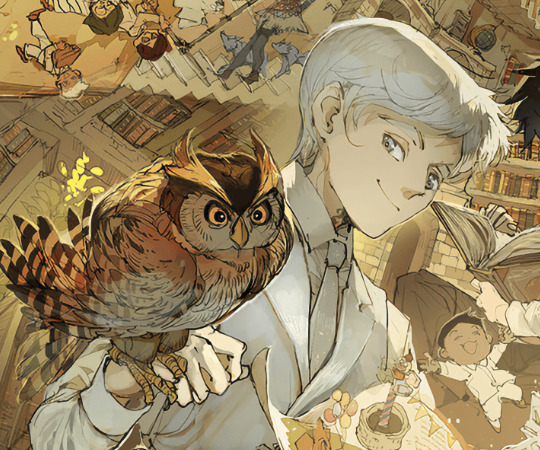
(spoilers for the entirety of The Promised Neverland, so if you haven’t read/completed the manga yet, consider this your first warning, because I’m once again going from start to finish with this.)
Since I want to stay consistent with the other two posts, this will focus on the manga timeline, as season 2 is, well.. it’s own thing. I’ll mention some things but don’t count on much. With that, let’s go.
- He achieves a perfect score on Grace Field’s daily tests, alongside Emma and Ray.
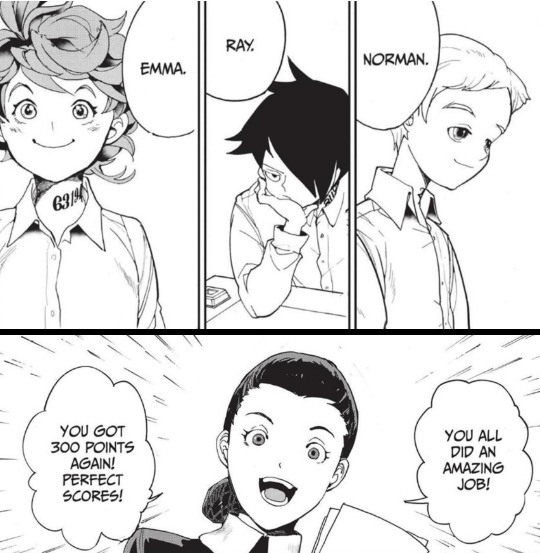
- He is, without a doubt, the smartest kid the house has ever seen, as he passes each test flawlessly and has maintained a 300 average.
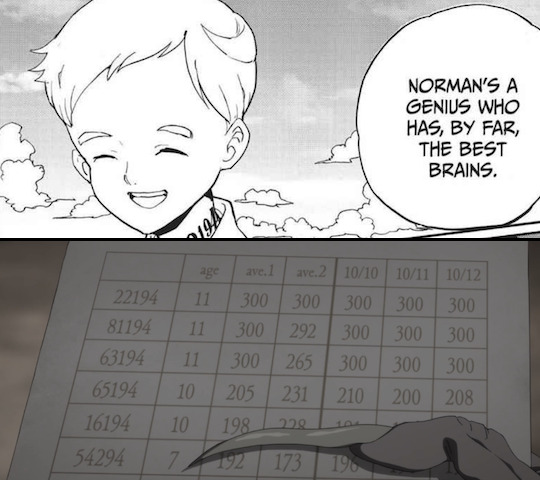
- He’s a complete strategist who is capable of achieving victory (even in something simple as tag) by observing his opponents moves and analyzing their weaknesses in order to counter.
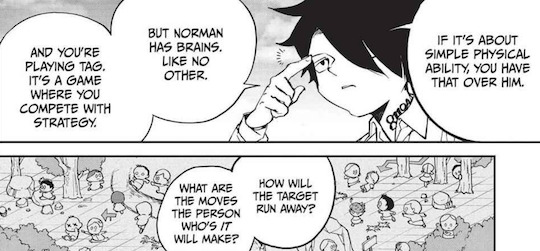
- Knows how to pick locks. The scene from ch1 was left out but we see him doing so later on in ep02.

- Stays relatively positive and calm after learning about the truth of the farm.

- Even going as far as giving Emma a reassuring smile, which I think is impressive given the literal nightmare fuel they’ve just witnessed.
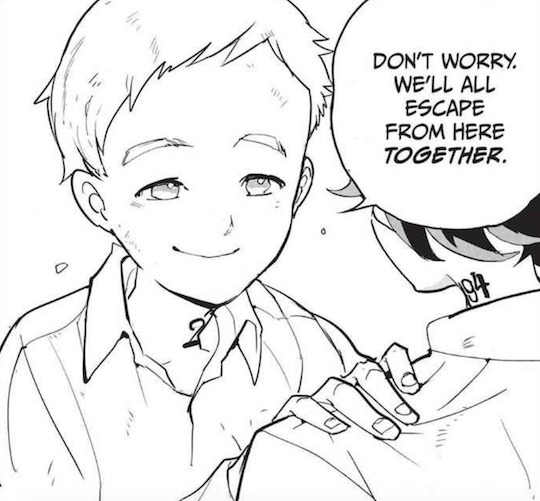
- I’m giving him half credit for suggesting the idea of there being tracking devices, since anime has him reveal this possibility while in manga it’s Emma.
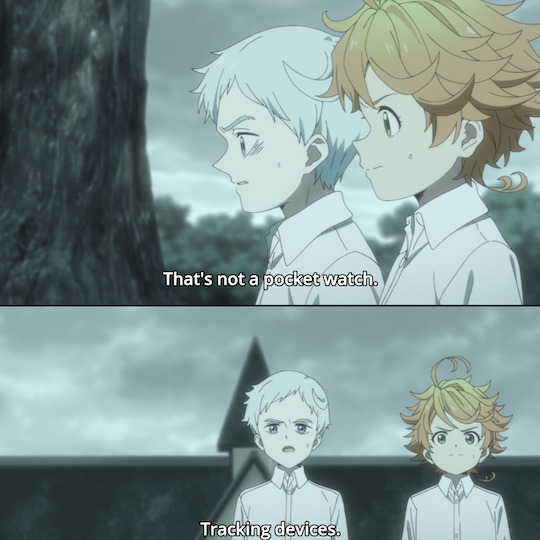
- Both of them realize what determines the shipping order and that the demons favor their brains.

- This silly panel that I love dearly.

- Made sure to do a sweep of the entire house beforehand to make sure their escape planning doesn’t get pick up on.

- Figures out that Isabella only knows the children’s locations when she checks the tracker and that it can’t identify who is who.
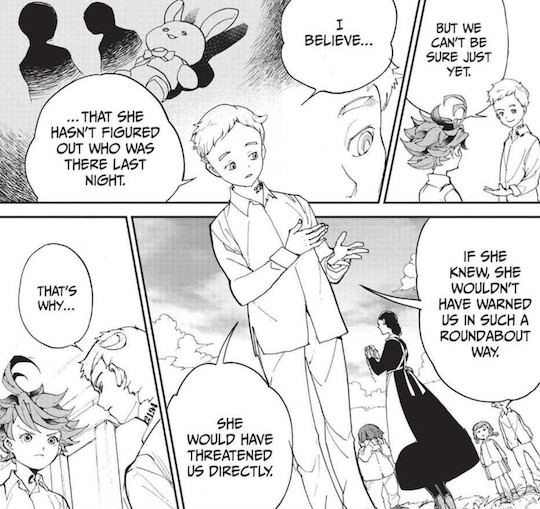
- Has the nerve to lie right to Isabella’s face.. not that she believes it, but still gutsy nonetheless.

- Knowing the house probably wouldn’t have any rope, it was his idea to use the spare tablecloths.

- Had a feeling that Ray would reveal the harsh reality of how dangerous it would be to escape with all the children, which turns out to be correct.
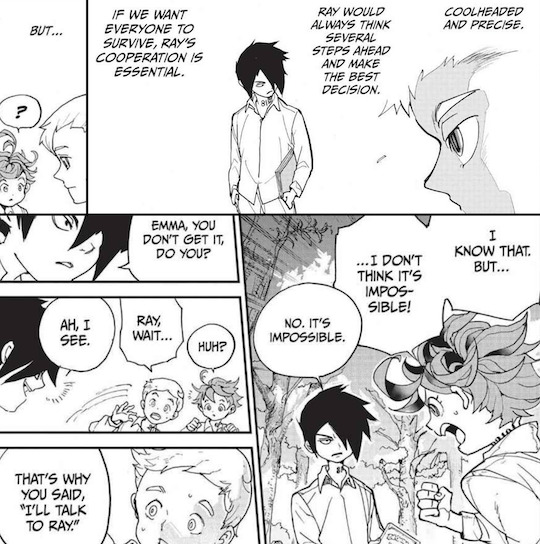
- His laugh in ep02 is so precious.
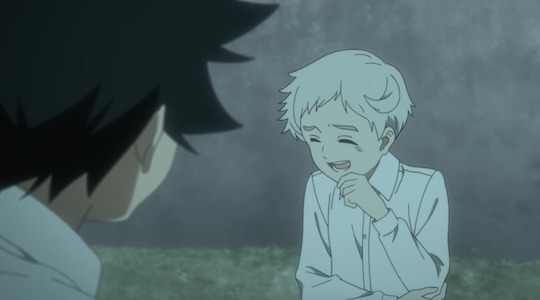
- This statement being 100% accurate.
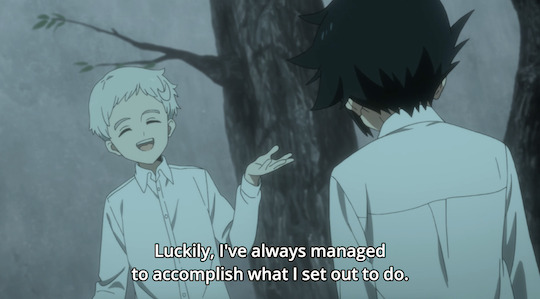
- Manages to convince the logical Ray, who we know now has spent many years coming up with a solid, safer escape plan, to join in and assist with their crazy and reckless plan instead. Having Ray on their side also grants them many advantages.
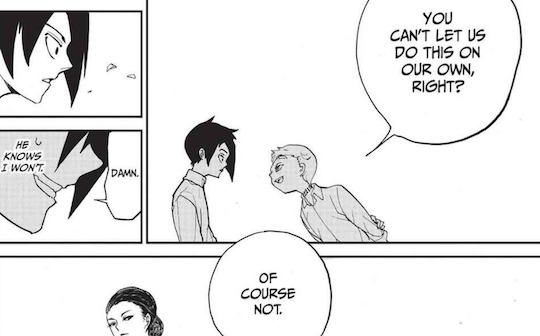
- Absolutely hates to lose, which is a good mentality to have in a world where your life is a stake and your time is limited, which eventually leads him to consider every possible opportunity to stay ahead of his enemies throughout the remainder of the story.
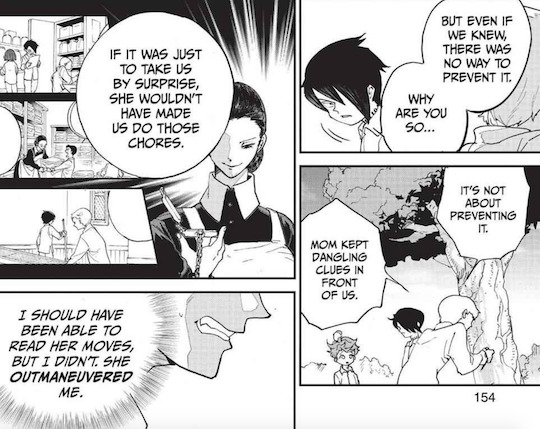
- Realizes that the trackers must only send out a signal upon being broken, which we found out to be true in Ray’s one-shot chapter.
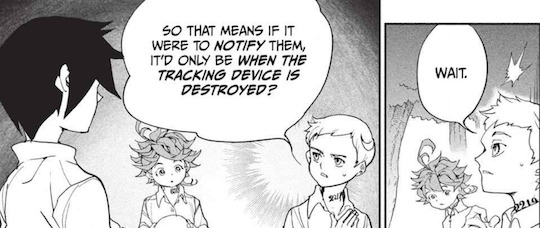
- - Him looking completely terrified in this panel.

- He managed to catch all the Grace Field kids in a game of tag even after they received advice from Ray about how to survive longer.
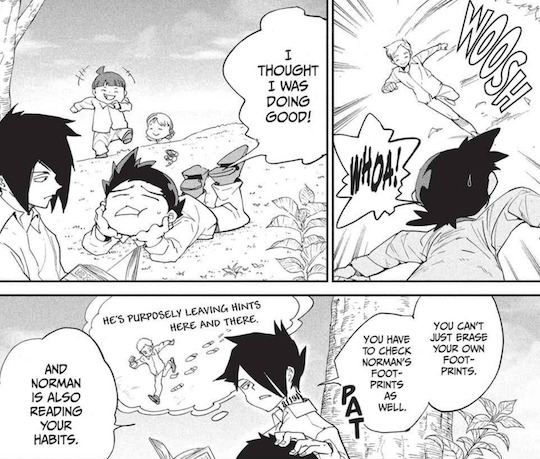
- The goddamn intimidating energy he gives off here is fantastic.
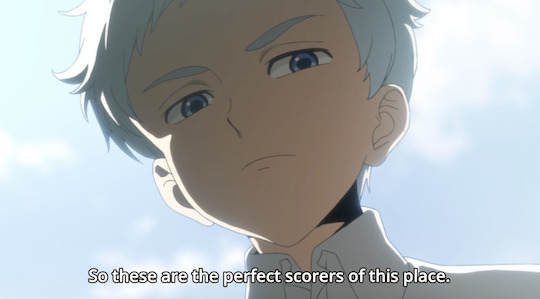
- Despite his body being physically weak, he manages to survive and win against Krone during their game of tag.
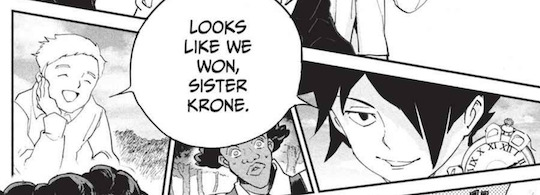
- Just like Ray some couple chapters ago, Norman is completely serious about this idea.
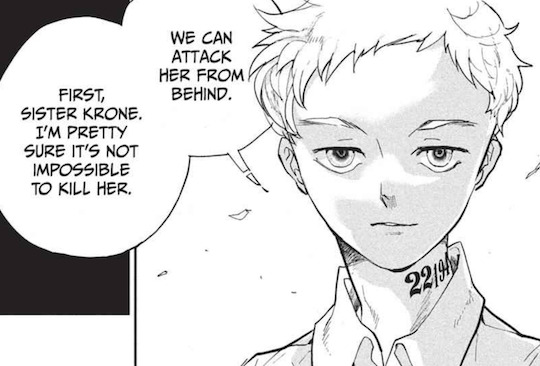
- Suspects there’s a traitor among the kids and swiftly comes up with a plan to lure them out.
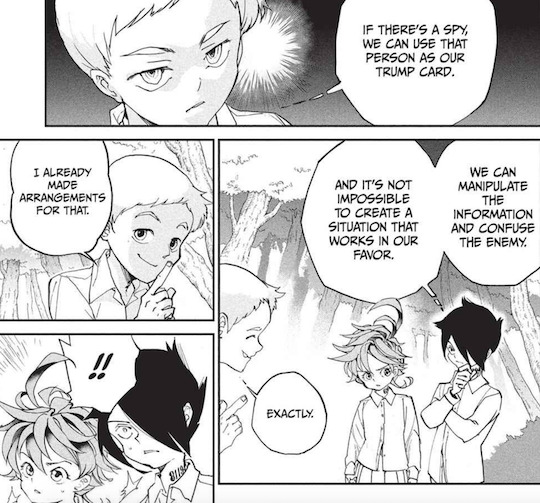
- This panel of him “dead” from the first side story.
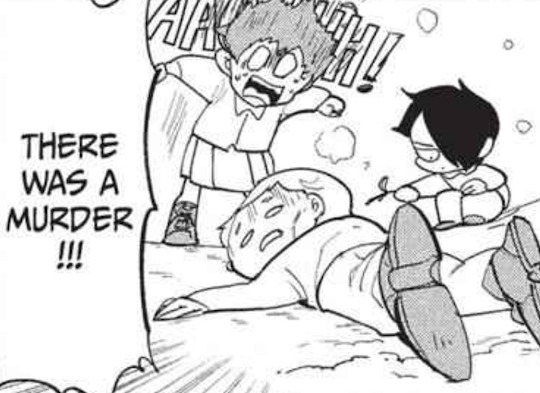
- He has a feeling the spy is Ray, so he moves up the day of the escape to catch him off guard and send him into a panic.
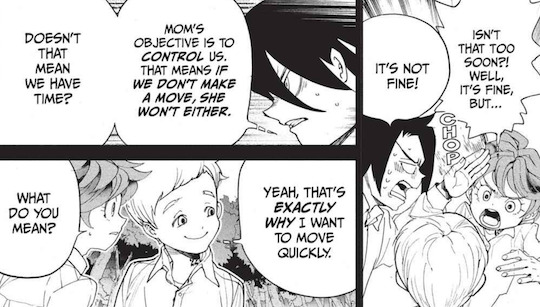
- Even though the anime didn’t include it, he managed to throw off Krone as well with some fake footprints to keep her off their backs.

- Was honestly considering on leaving the spy behind while the rest of them escaped, though he doesn’t seem real happy about the idea, considering the traitor is Ray.
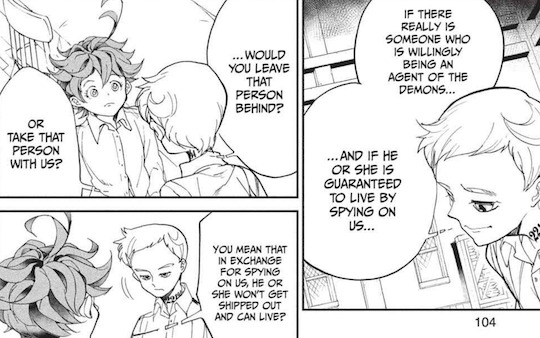
- His plan on fishing out the spy was flawless as he finally calls Ray out by revealing that the information he gave about the ropes and where he hid them were fake locations.
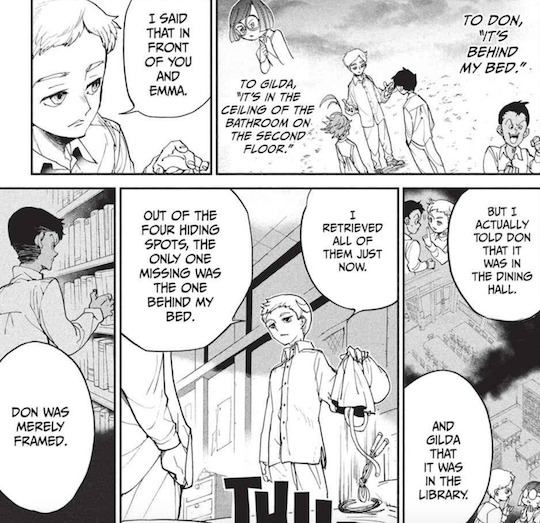
- Not only was Ray the first one Norman suspected, but he caught onto him way back when Krone first came to the house. All the information Ray was feeding them helped Norman come to this conclusion as well.
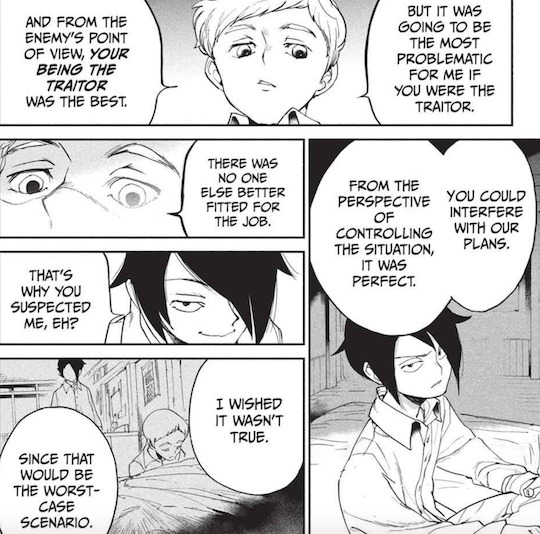
- Along with Emma’s words about believing that no one in their family is truly bad, Norman refrains from cutting Ray off to allow him to become their trump card. This was a risky move itself, knowing Ray could sell both him & Emma out at any time. Norman tends to prioritize victory, so while staying alive is absolutely necessary and that could’ve been achieved without Ray (as he could’ve just used Ray then ditch him later), he still decides to make the offer as realizes that in order defeat Isabella, Ray’s full cooperation is essential.
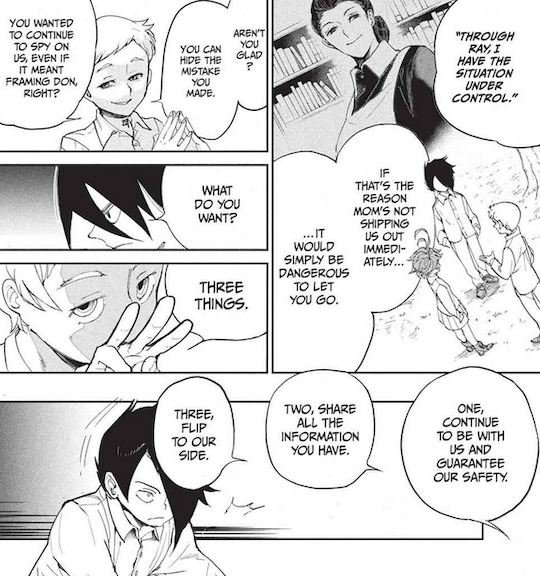
- Realizes that it was Ray who hid Little Bunny in the first place and lead Norman and Emma to investigate the gate that night, which leads him to believe that Ray isn’t really an enemy.
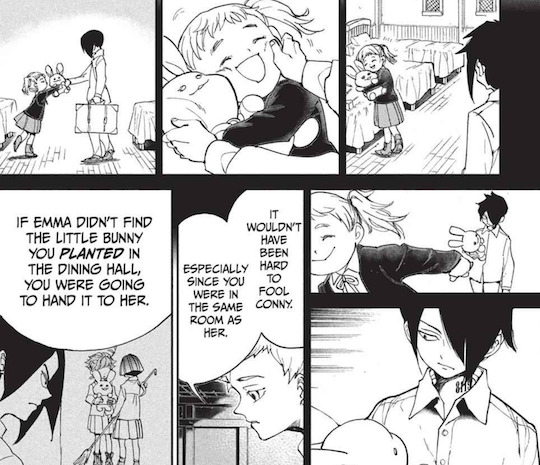
- He’s also left handed. Yes, that’s important. Not only for later in the story but because we’re superior. I’m sorry y’all had to find out this way.

- This stupid, little face he makes.
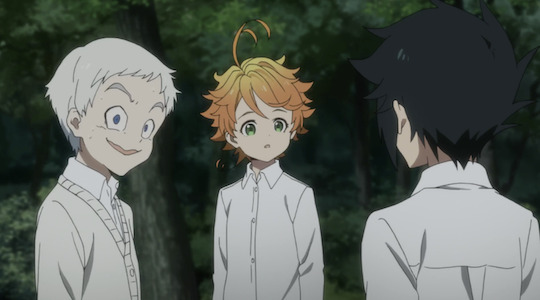
- Suspects that Ray doesn’t actually plan on escaping at all and intends to kill himself.

- Just like Emma and Ray, Norman also recognizes and understands morse code.

- Look at this precious child, not even angry after getting punched and knocked over. (because i certainly would be)
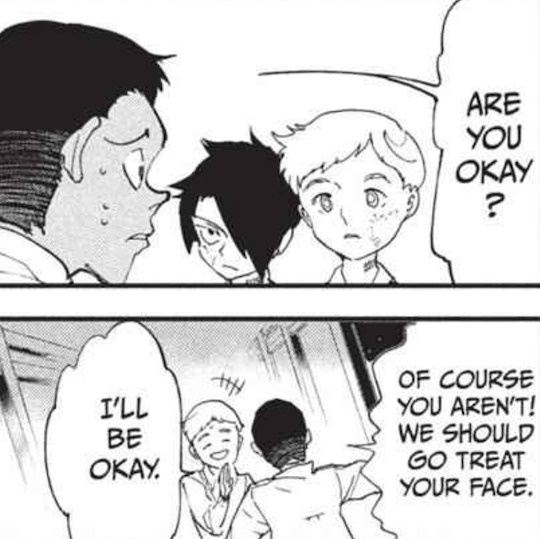
- Finds Ray’s hidden supply of oil which confirms the method for his future suicide. This also helps Norman later on when he comes up with a refined escape plan by using the fire Ray plans to start.
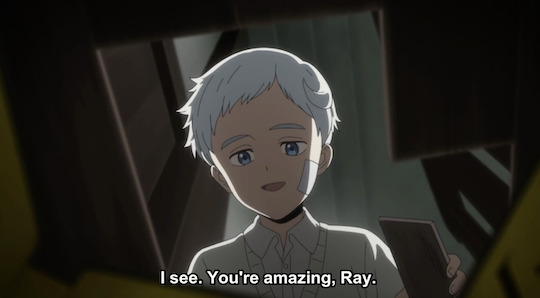
- Figures out Krone’s true intention about why she wants to join forces with the kids in the first place.
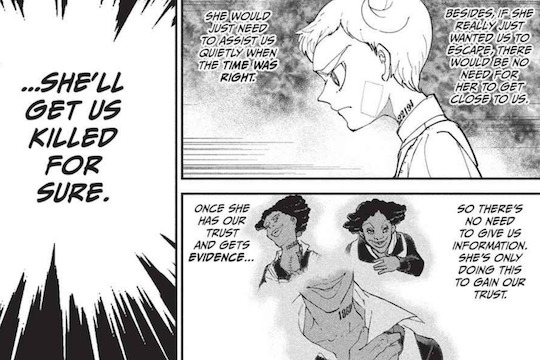
- He ends up accepting Krone’s offer anyway, because despite the large risk, any information that can snag out of her would benefit them.
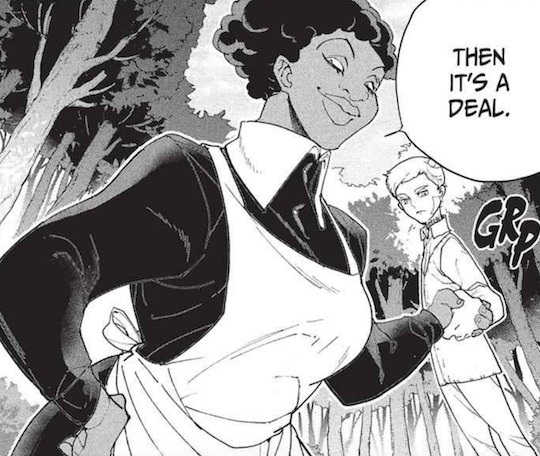
- You mad lad, look at you, taunting the bringer of death yet again while a smile on your face.

- And he still manages to find some strength to smile while upon death’s door.

- Not for long though, as once he’s given the chance to be alone, he finally breaks down. Having the cup overflow with water really helps demonstrate how impactful the thought of dying hit him as Norman was overcome with so many emotions that he didn’t even have the strength to hold onto the cup or his facade. It’s then he starts to feel scared and sorry for himself but away from Emma and Ray’s eyes as to not worry them.
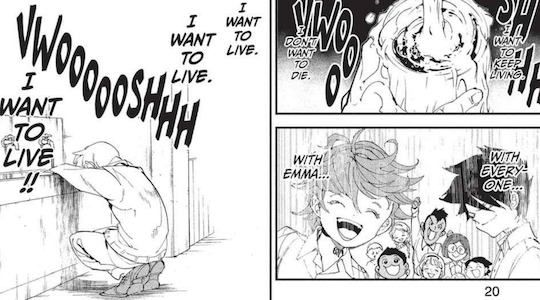
- His entire internal monologue as he comes to terms with his unfortunate situation and flips back to his determined “I can’t lose” attitude to help everyone else escape. Also, his theme ‘22194’ hits especially hard.

- For someone with weak, physical abilities, he manages to climb the wall on his own.
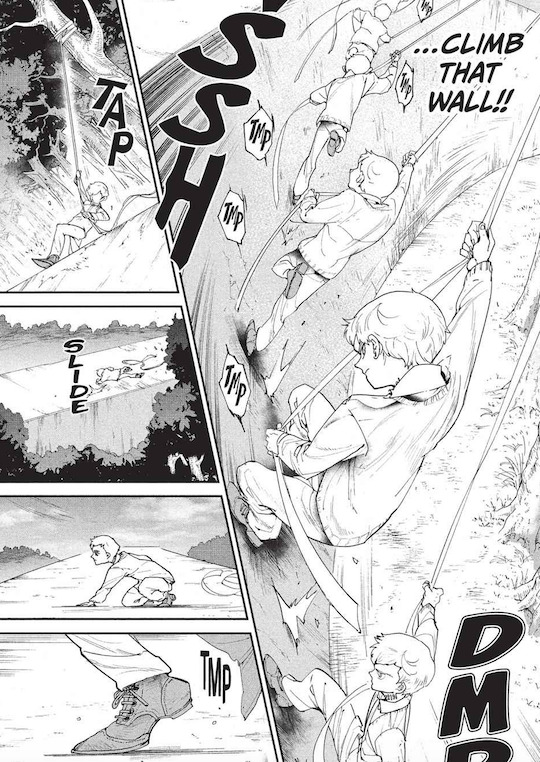
- Though the cliff stopped his escape, he used that opportunity to survey the surrounding area of the entire farm to rely his findings to the duo and provide them a safer escape route.
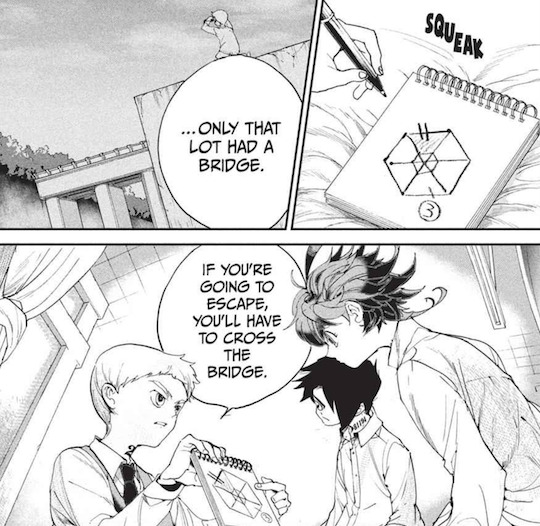
- Completely adamant about his decision to accept his shipment in order to give the rest of his family a chance to escape. (hell, id’ be terrified right now)
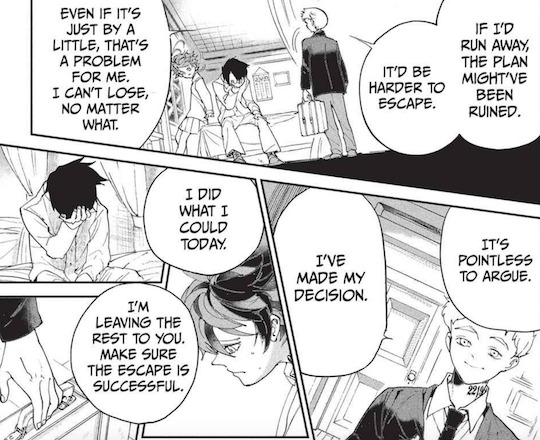
- This hug that is sure to break everyone’s hearts.
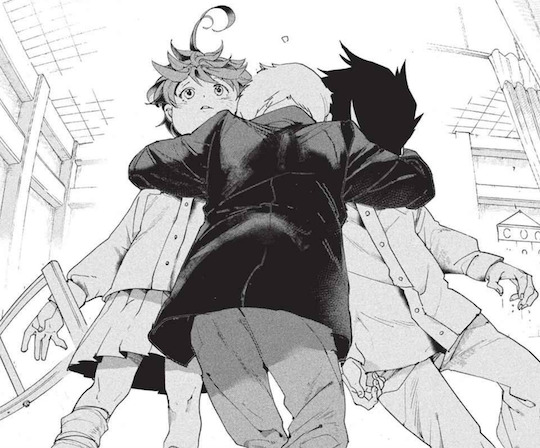
- Quick to react to Emma’s last ditch effort and prevented her from slamming her already busted up leg into the ground.

- Not only did he predict that Ray would start a fire to distract Isabella and on which day, he also left behind the pen and key he received from Krone along with a new, detailed plan (which he managed to come up with in only a few hours by the way) that would allow the kids to cross over the cliff.
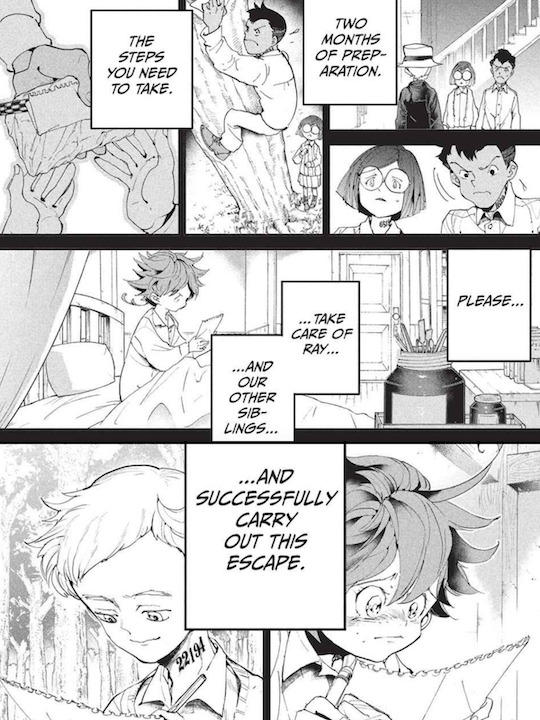
(post season one spoilers below. again, focusing on the manga timeline, so any new season 2 events will be mentioned sparingly.)
- Like Ray, Norman was able to figure out how the pen worked well enough to see Minerva’s message regarding B06-32.

- Since he doesn’t show up again for quite some time post-escape, there isn’t much to talk about.. but at least I can make fun of him thanks to extra pages, like how he wouldn’t have enough strength to use a bow.

- But hey, props to s2ep10 for actually giving us Norman shooting an arrow. He was pretty decent with it too, as he hit his target on the first try behind a darn smokescreen. The manga did show him holding a bow in ch161, but that’s it.
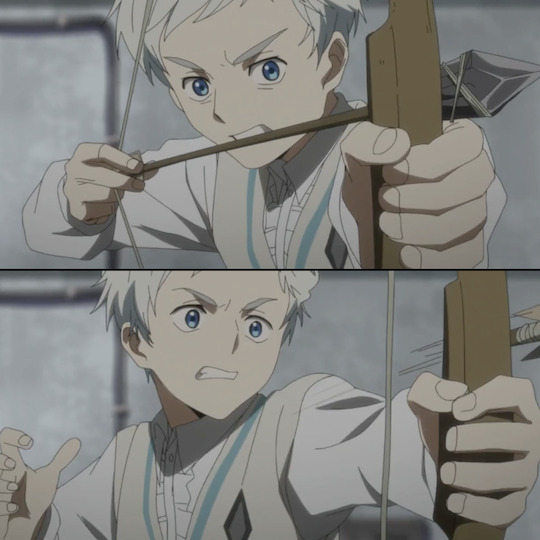
- Not relevant to the actual story at all, but his smarts certainly make anything possible.
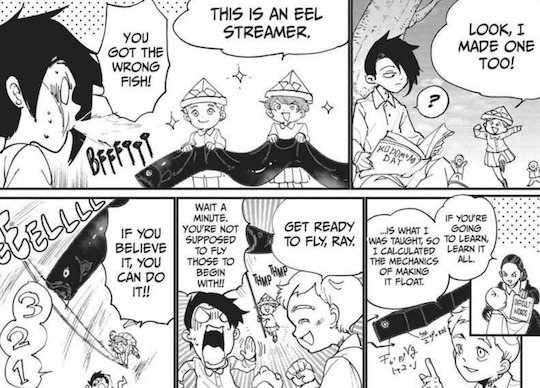
- I’m sorry but these tiny failures of his bring me great joy.
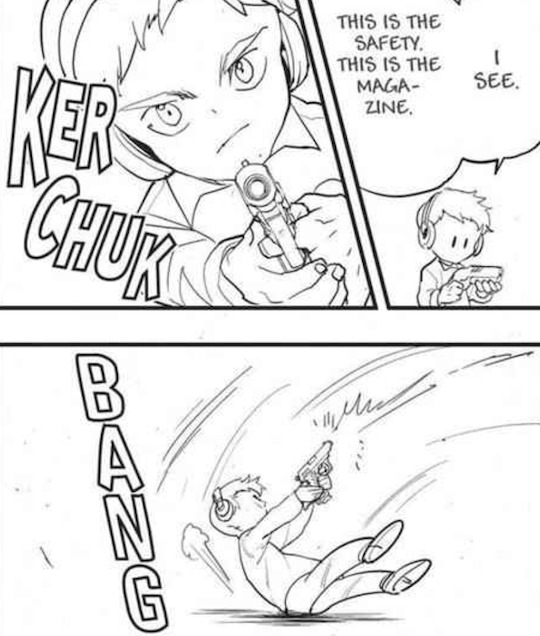
- Though the tests at Lambda are harder than those at Grace Field, Norman still managed to get every question correct. Every single day he was there. Even when the facility manages to increase the difficulty of the tests, he continues to pass each one with flying colors.
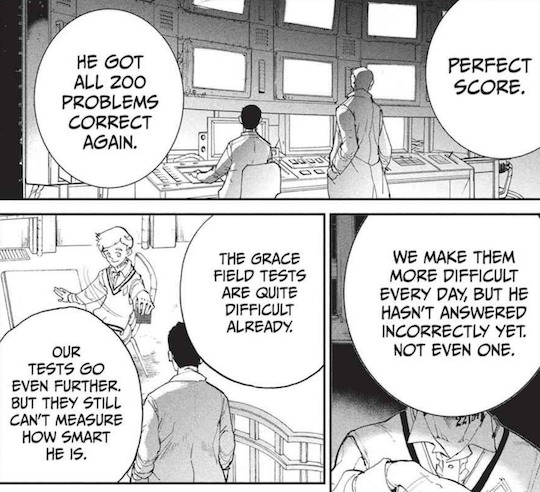
- Since he noticed someone who’s right handed also takes the same tests he does, he makes an attempt to communicate with them via a Rubik’s cube. He waits patiently for five months until he finally gets a response from Vincent around Christmas 2046.
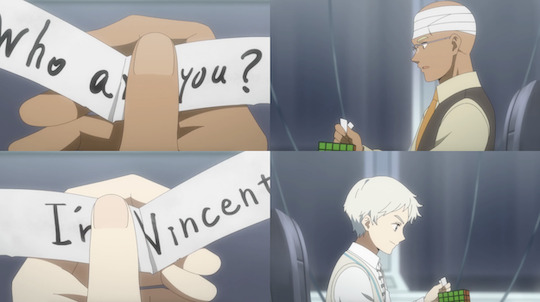
- Dealt with the experiments/drugs that were forced onto him and the seizures that resulted from them.
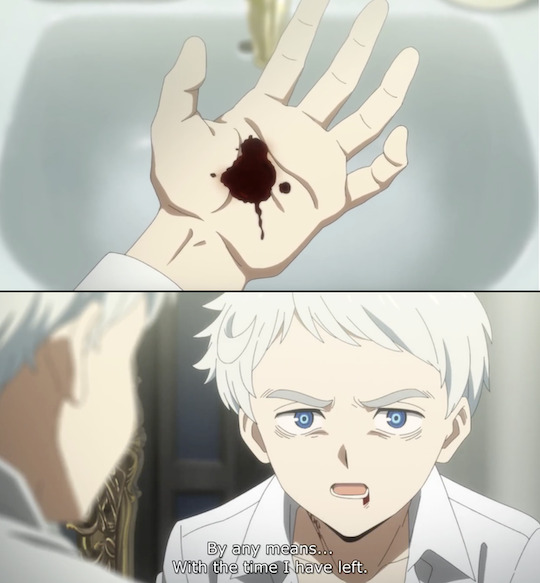
- Even with the tight security and surveillance, he somehow acquired explosives and successfully blow up Lambda and escapes with the survivors.
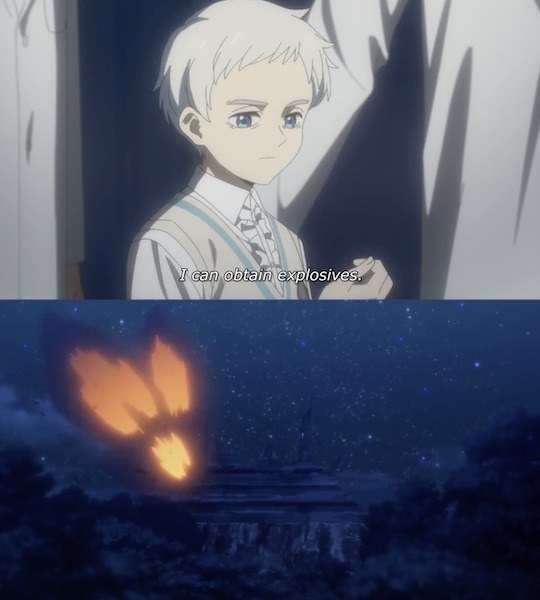
- Again, not significant to the story, but seriously dude? You just fainted and yet you still get this crazy question right effortlessly?
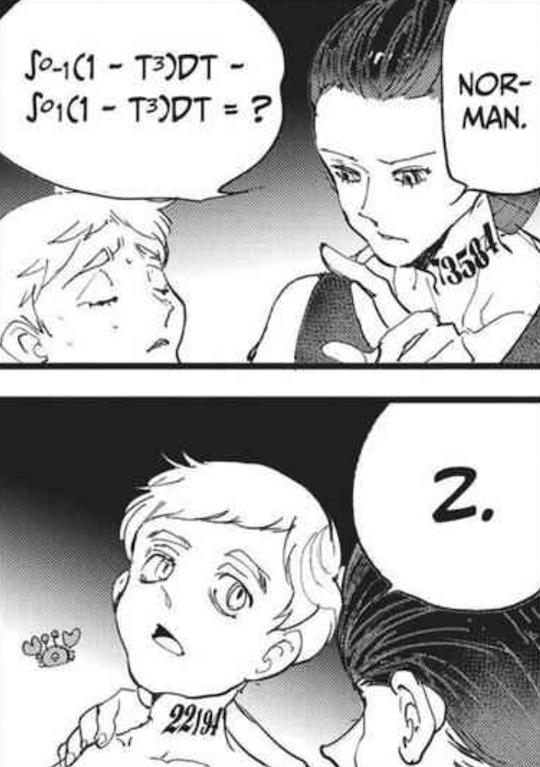
(post time-skip)
- Contacts Lucas moments before the B06-32 shelter gets blown up and gives him the numeric code that eventually leads Emma’s group to the “Jaw of Lion.”
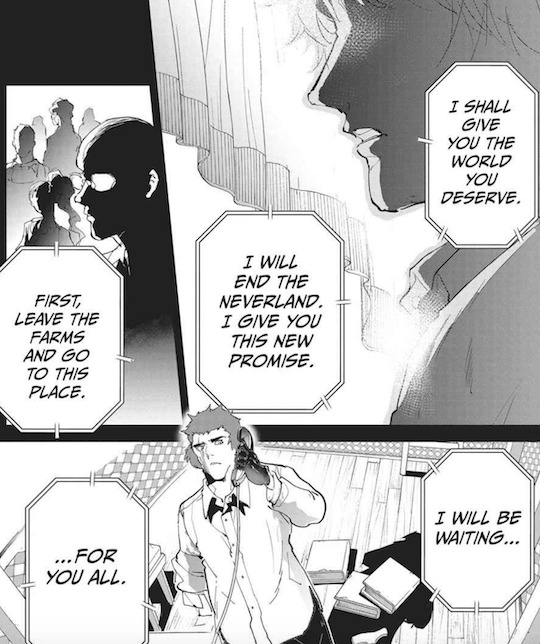
- Destroyed numerous mass production farms since his escape from Lambda.
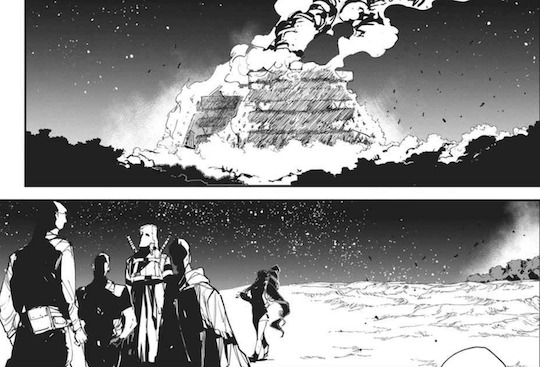
- As well as save countless children from other farms and used the Paradise shelter found by Smee’s network to give them a sense of safety and taste of a normal life.
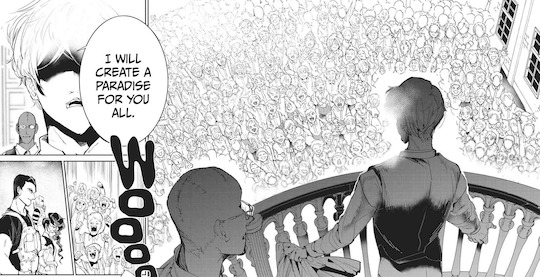
- The darn glow-up he receives, like sweet lord child, are you sure you’re still 13??
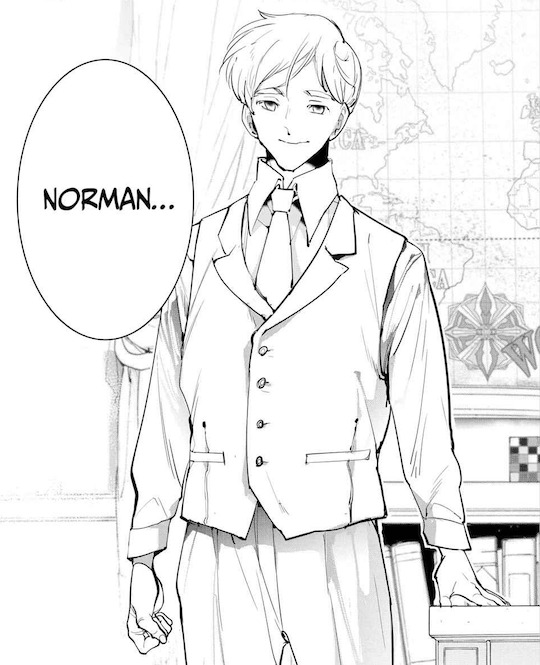
- - His cute, squishy cheeks though!
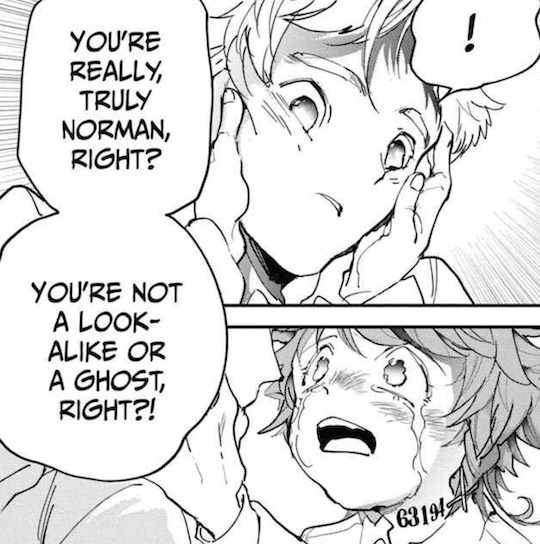
- He may look like he’s in his thirties, but still has the strength of a child. (see anime? this is how strong ray’s slap should have been!)
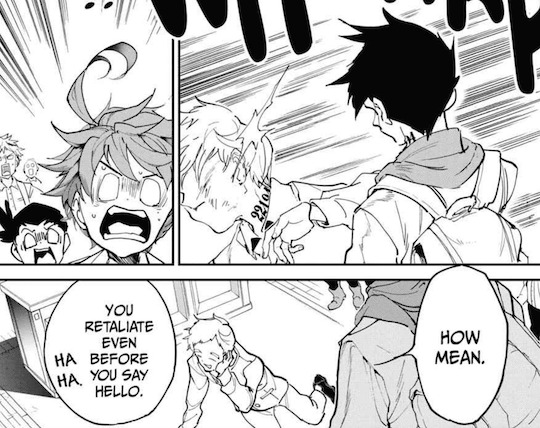
- Learned a great deal of demon history and gave that lengthy lesson about the demon’s genetics and how they inherit the characteristics of whatever they eat and evolve accordingly.
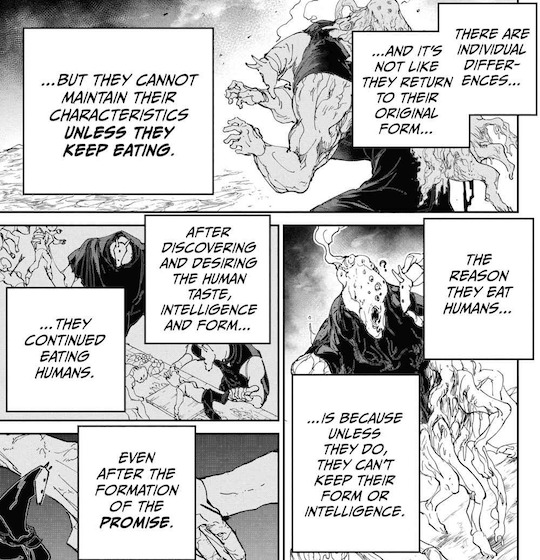
- With Emma’s wish about saving everyone and lively happily still on his mind, he thought of a safe and certain method in order to create such a future for all the children raised as food.. which ends up being complete extermination of all the demons caused by a civil war. His plan also includes ending the Ratri clan as well. How cheerful.
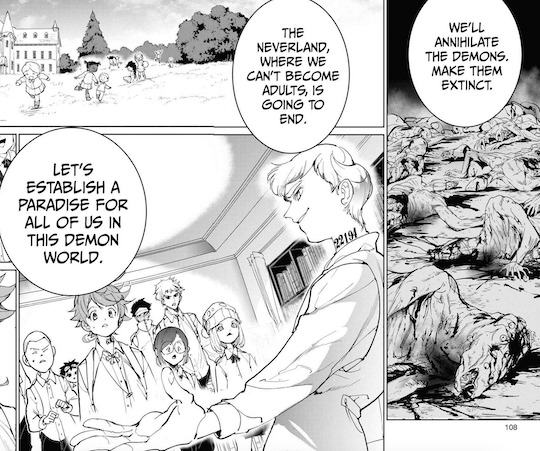
- Are you surprised to learn that Norman getting tackled by the younger kids is my favorite panel of him?
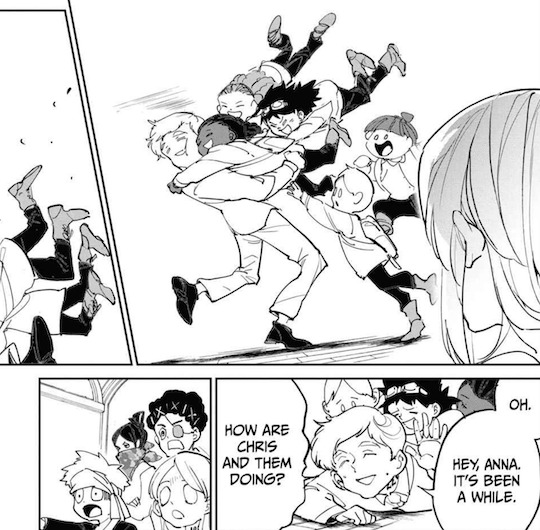
- You weak, little bean, I’m sorry I enjoy making fun of you so much.
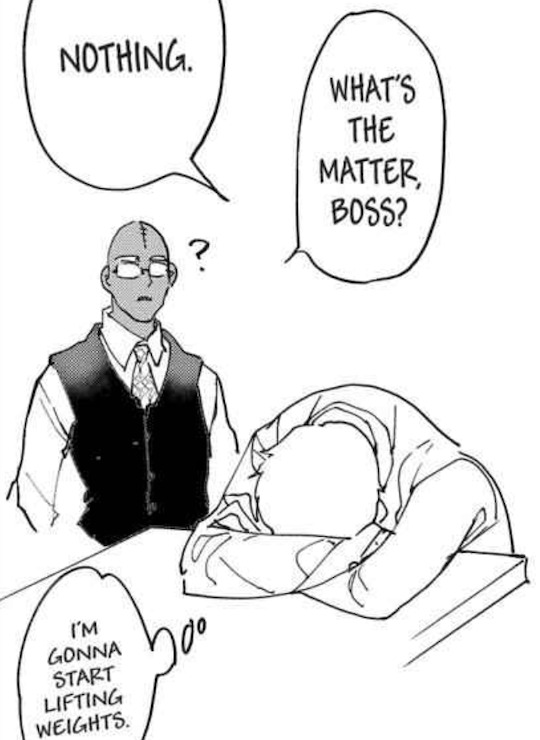
- Successfully forms an alliance with Lord Geelan and his clan by offering revenge on the royal family, the five regent houses, as well as the Ratri clan, thus putting Geelan in full control. In return, it would grant Norman the full release of farm children, permission to self-govern and some much needed power in terms of demon strength.
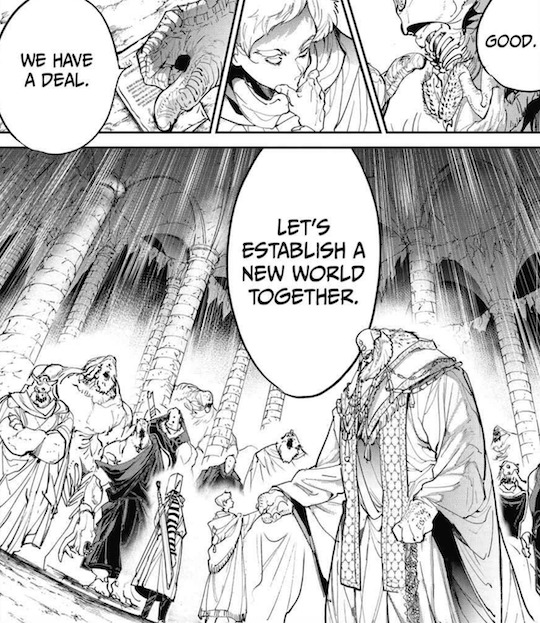
- He knows full well that the entire alliance is a lie and both parties are only using each other, though in works in his favor, as it will send the demons to destroy each other without the lose of any human lives.
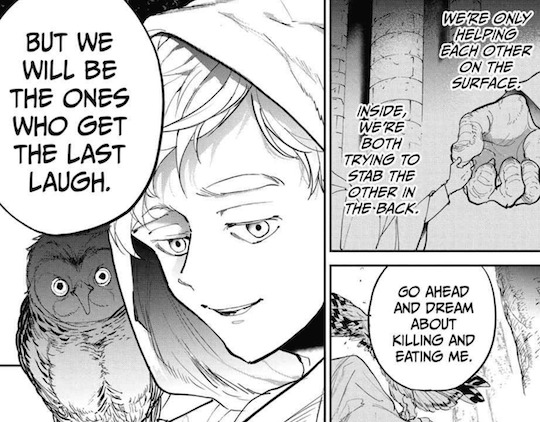
- This absolute powerful panel that the anime decided “nah, we’re gonna change this too” because they’re cowards.
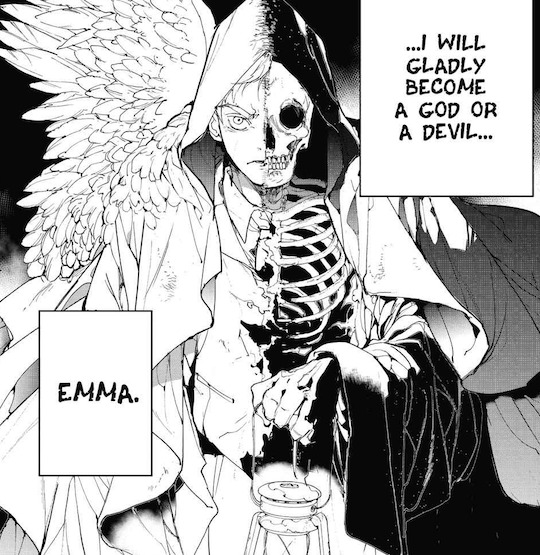
- Narrowed down possible locations on where to find Sonju and Mujika. Sure it was with the intention of killing our demon friends but his map was accurate.
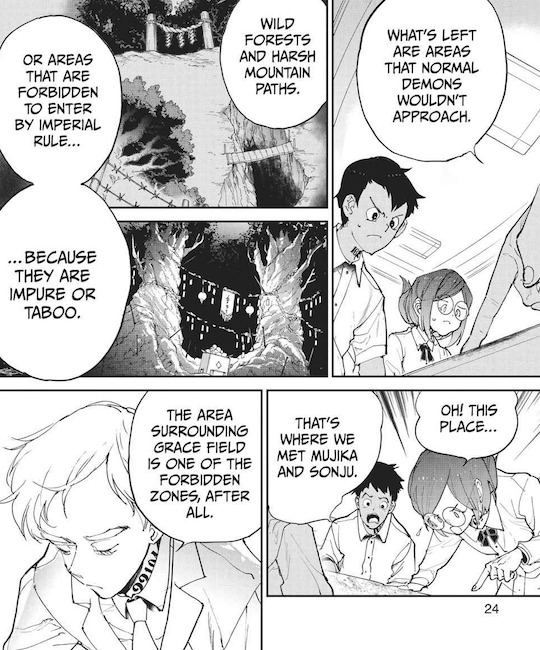
- Survived who knows long with his seizures at level 4, and because of his severe condition, he’s completely set on following through his plan and succeeding before his time runs out.
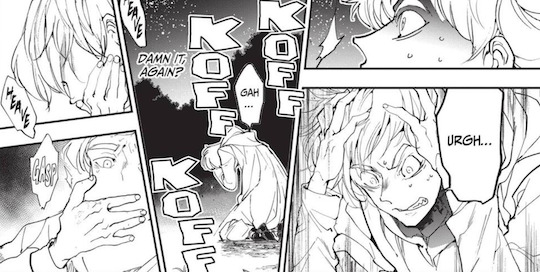
- Seems to enjoy blowing stuff up, such as the imperial city’s bridges to send the place into a panic and trap all the citizens.

- Advised the Lambda crew on how to effectively fight against the queen by attacking relentlessly.
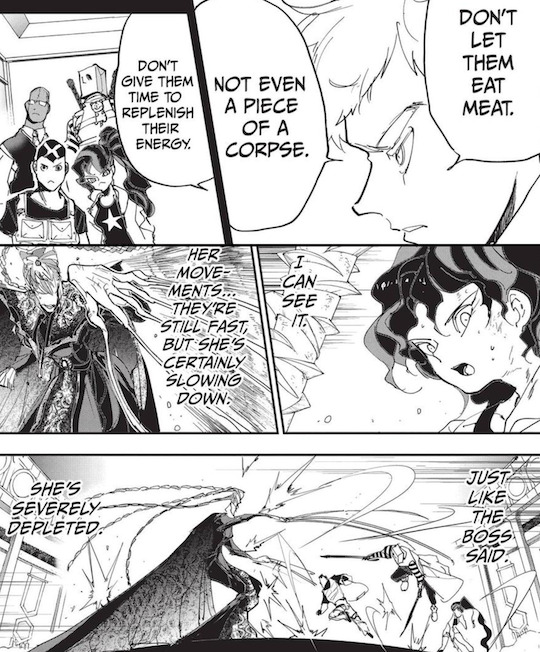
- Let loose a poison that causes not only normal demons to degenerate, but the royal family as well, such as the five regent heads and the queen who’s name is too long and complicated for me to ever remember, who all have the cursed blood. (at least that’s how effective it was in manga, in anime it did absolutely nothing to vylk)
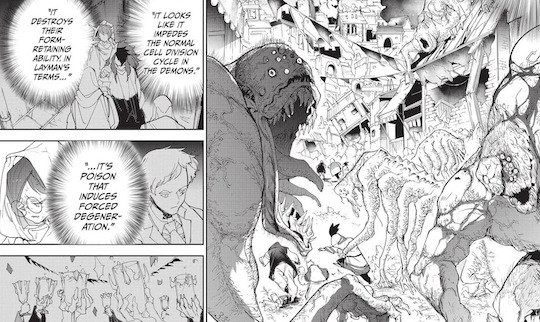
- He somehow managed to learn, speak and understand the demon language, which, according to Shirai (vol16 author notes), is actually an uncommon language nowadays. (and we’ll unfortunately never know how this language actually sounds, thank anime..)
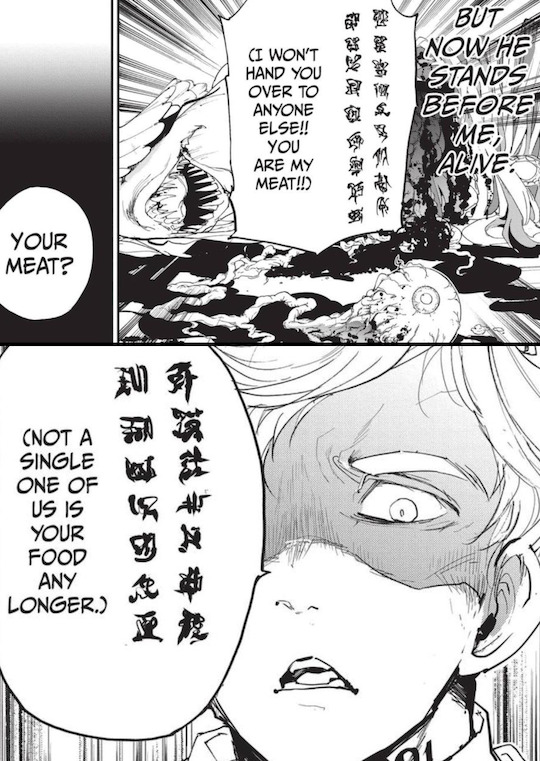
- Do I even praise him for killing a demon and well.. all this? Sure in the anime he tried killing Vylk, but old demon was fair more innocent compared to the royal family, so I have no idea.
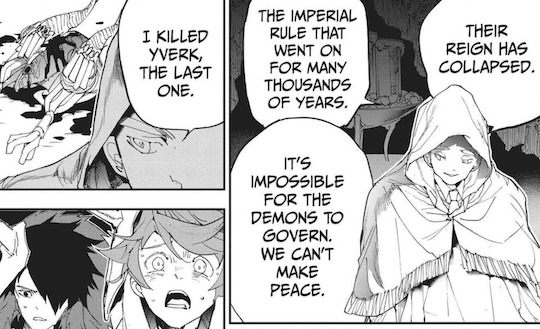
- I will give season 2 some credit and say I prefer their take on the “right now you look like a small child, shaking with fear” panel.
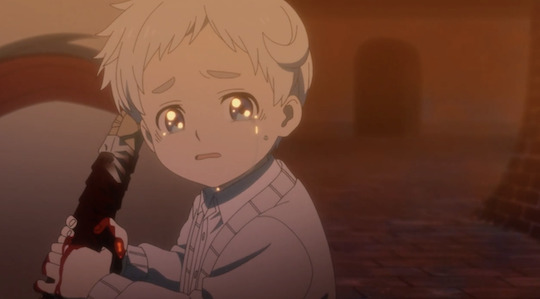
- But not too much credit, as they didn’t give us the full trio hug as the manga did!
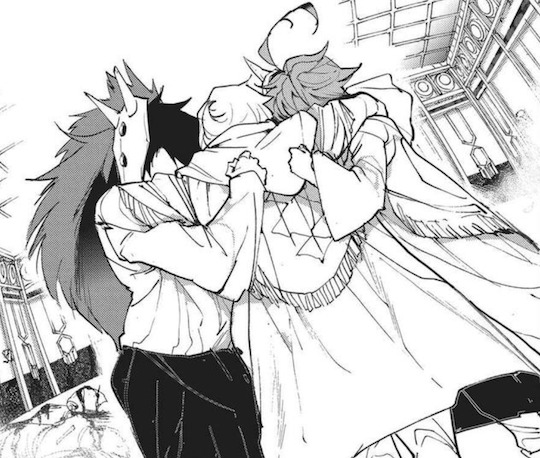
- Then again the anime did have him about to apologize to Vylk and Demon Emma for his actions, which is something, I suppose? since in ch154 he says he didn’t regret killing the queen and royals, which I guess is justified because they were the bigger problem, but oh well.
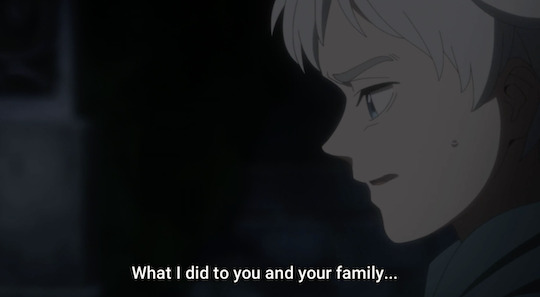
- Might have apologized to Ayshe for killing her father? Can’t be sure but that’s the unanimous consensus in the fandom right?
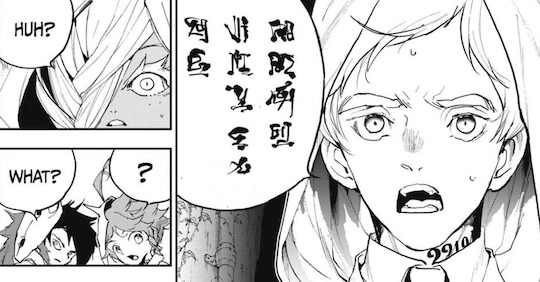
- Instantly comes up with counter moves and directions for the entire group upon hearing the enemies locations from Vincent during the GF raid.
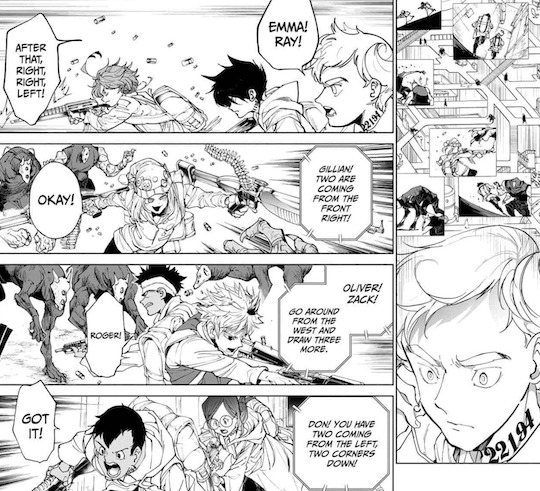
- I honestly can’t look at this panel anymore and not laugh about it.. because reasons.

- He just keeps on winning. (also he looks real good here, i’ll give him that.)
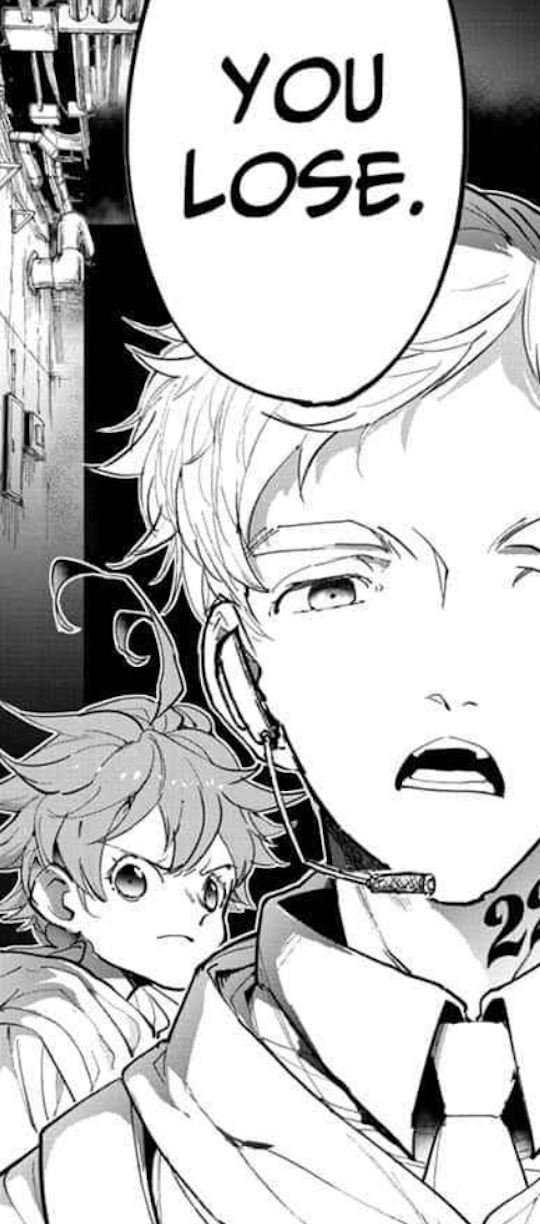
- He and everyone else are skeptical about there being no “reward,” and for rightfully so.
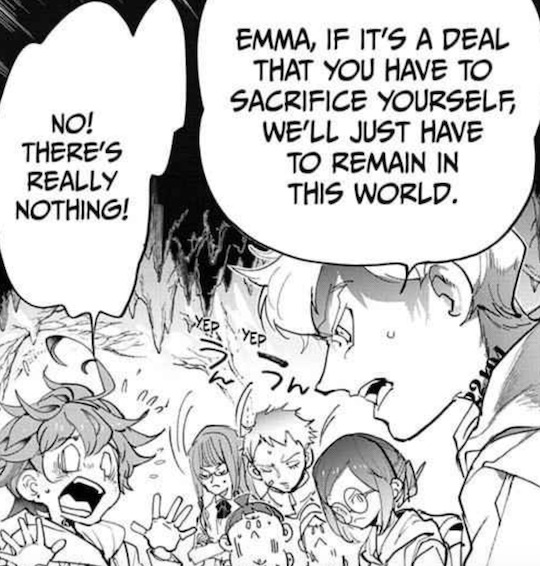
- Upon learning that Emma is missing after everyone crossed over to the human world, they all adopt her optimistic attitude and swear to find her no matter where she might be.

- After a stressful two year search, the kids finally find Emma and Norman is so overcome with emotion that he busts out into tears of joy, despite finding out that she lost her memories due to the reward. All that matters to him is that Emma was safe and happy and he accepts her just the way she is.
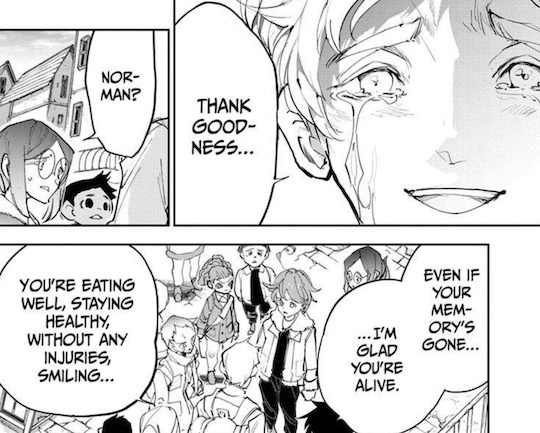
And I guess.. that’s it. I’m sorry again, I know this is truly the weakest post out of the trio and I have no doubt I glanced over a whole bunch of great moments but it still had to be done! Making fun of him probably wasn’t the best thing to do on his special day either, but I assure you this child is very powerful. Who else do you know that is capable of sending an entire fandom into a panic and rage furiously by just simply showing up?
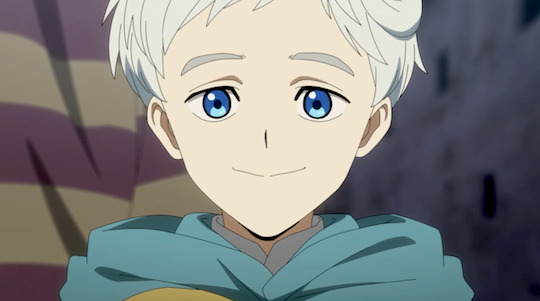
Ah ha okay, now I’m done. In all seriousness though, this lad is great and through everything he has endured, he definitely deserves to be celebrated today, so happy birthday to our boy Norman!
49 notes
·
View notes
Text
When it is done right, there is nothing cooler than professional wrestling. When it is done right, you can see colorful characters doing battle and feel like you are part of a community. Wrestling should be for everybody, but sadly its history has not always lived up to welcoming those who are not straight men. For five hours on Saturday, April 24, in the backyard of an abandoned(?) house in Pittsburgh, in the rain, one of the coolest and most entertaining wrestling shows ever took place. MV Young presided over the proceedings of the 3rd installment of the PolyAm Cult Party.
If you have never seen MV Young, imagine the most jacked version of Billy Idol you can. He is polyamorous, pansexual, fashionable, claims to have thousands upon thousands of sexual partners, is charismatic enough that nobody doubts it, he brings a real DIY punk rock feeling into indie wrestling, and has built a brand so strong that everybody accepts “PolyAm Cult Party 3” as an excellent name for a wrestling show despite being a far cry from “the Royal Rumble” or “SuperBrawl.” MV is the Wrestler’s Lab Champion, the King of the PolyAm Cult, he straddles lines between subcultures, is always defiant to his detractors, and ready to boost his followers. He also has one of the most refreshing visions of pro wrestling and its future, and this show that he created was a resounding success.
Appropriately, the pre-show entertainment at the PolyAm Cult Party was punk band Big Baby. This show brings the energy of a backyard punk show to wrestling. The intermission was provided by drag superstar Washington Heights. These three art forms/subcultures can absolutely fit perfectly together, enhancing one another and growing the audience for each. This also serves as a perfect description for the vibe of the Party, wrestling + punk + drag = PolyAm Cult Party 3. The other crossover star in attendance was Commander Sterling (whom I am familiar with from Kate Nyx’s Generic Winter Holiday Special), who returned to the Party, bringing a sizable following of non-wrestling fans to watch them both wrestle and manage evil lawyer David Lawless, having turned full heel since the last Party when they served as the ring announcer.
Many of the wrestlers at the Party fit into the LGBTQIA spectrum, but most of them do not make it the major part of their persona, and none of them felt like they were booked for this reason, or to fill a role, or like they were chosen for any reason other than their abilities. Unlike some “specialty” shows, the wrestling was the main course at the Party, and every aspect of a good wrestling show was on display. We saw hard hitting strikes, high flying flips, heel beatdowns, babyfaces overcoming adversity, comedy, an epic Scrumble, and a few huge stars, like Lee Moriarty and Allison Katch. Wrestlers were given the freedom to fully express their personas and we saw wrestlers CPA return to an old identity to battle former WWE Superstar Colin Delaney, and Allison Katch utterly destroy the fandom’s perception of her with her new one. Wrestlers of every shape and size also featured at the Party, from the diminutive Yoya to the aptly named Big Callux. None of the matches on the show felt like foregone conclusions (except Callux’s squash of The Bird) and none of the events of the day felt forced or like an illogical swerve.
The show started in grand and appropriate fashion, with the Satanic El Presidente Pinkie Sanchez standing atop a Jeep (one of the unique elements of this literal backyard show). To the dismay of the crowd, he lost his contest to Darius Carter, an overly serious and egotistical wrestler with a phenomenal jacket who made a perfect heel for the gathered Cultists. Over the course of the day we saw the technical wizardry of Edith Surreal (whose matches have been appointment viewing for me since the last PolyAm Cult Party) as she triumphed over the similarly impressive Eel O’Neal, Shawn Phoenix using a flaming board as a weapon in the scrumble before being one of several opponents to fall to Mikey Banker, before Aspyn the Mermaid claimed the victory for her simps, and a good ol’ meaty hoss fight between Mr. Grim and Chase Holliday, a hard hitting battle between Xavier Faraday and Yoya. MV Young defended his belt against Jody the Wrestler, who won over a large part of the crowd with his fighting spirit despite facing the leader of the Cult, unforgettably incorporating a cigarette into the match en route to a successful defense. Cold blooded villain Charles Mason upset indie wrestling superstar Lee Moriarty in the pouring rain (and earned an “Eat The Rich” chant from the crowd, because the PolyAm Cult is an excellent and discerning fanbase). Molly McCoy had a standout match in the second PolyAm Cult Party in a row, falling to the terrifying badass Allison Katch, and Ziggy Haim defeated Janai Kai early in the night and came back from a beatdown on her way to winning the Ryse Wrestling Championship and the adulation of the entire crowd in the main event.
You might assume that a wrestling show being broadcast free on Twitch from a backyard during a rainstorm would not have great production standards, but GoProfessionalWrestling ran a tight ship, correcting all technical difficulties in a manner of seconds. Commentators Darnell (from Uncanny Attractions) and Scotty Sariti were a great team of personalities without detracting from the action in the ring, and Percy Davis has become one of the best commentators in indie wrestling. No ring announcer brings as much excitement as J Rose and this Party was the perfect event to showcase his passion. Even referees Nick Shin and Katy Vella were excellent and untiring for the length of the Party. The atmosphere around the ring included a firepit, several trees, and the aforementioned Jeep and all of these were used as weapons, though effectively and sparingly. None of the matches went too long and all of the wrestlers were welcome additions to the show.
In conclusion, wrestling does not need to be the same thing it has always been. It doesn’t need to play with the fans expectations. It doesn’t need to gatekeep people out of the fandom and it sure as fuck doesnt need to be uninviting to people of various genders, sexual orientations, races and religions. Wrestling is best when it gives us compelling characters that we want to see do cool shit in and around a ring, and when fans will sit for over five hours through a rainstorm I’d say the PolyAm Cult Party 3 delivered in abundance. Check out the replay on GoProfessionalWrestling’s Twitch channel and join the muthafuckin PolyAm Cult.
5 notes
·
View notes
Text
Tobio Kageyama MBTI [ISTP]
It was really funny to see people typing Kageyama as either ENTJ or ISTJ.
First, I feel like what people describing as Te, is Kageyama's Ti/Se working together. I disagree that he is extroverted, I feel like he uses a LOT of Ti, and I'll elaborate on this further down the post. And his Fe inferior is just so blatant.
Pretty much the entire conflict Kageyama faces in the beginning of the manga/anime arose from his difficulties in connecting and building rapport with others. It’s natural for everyone to want to win, but the very callous way in which Kageyama communicated this (“Jump higher!” “Faster!”) without considering his teammates’ feelings was indicative of immature inferior Fe. When he was fresh out of Kitaichi, and very new to Karasuno, Suga wondered why Kageyama didn’t look down at him for being less skilled and that's because of "Trust.. and stuff..". Kageyama is a naturally confident person but is insecure when it comes to anything to do with relationships between others. And after what he experienced in Kitaichi, he was finally able to understand how valuable being a trustworthy and understanding teammate is.
An immature IxTP doesn’t see the value in that and like Kitaichi! Kageyama, would rather priorities (their idea of) efficiency at the expense of other people’s feelings (immature Ti, very underdeveloped Fe).
Inferior Fe also explains why Kageyama experiences so much difficulty connecting with others, it’s just something that doesn’t come naturally to him (contrast this to Suga, a Fe-dom, who’s in his element when connecting with the team, never ever failing at making them feel at ease). And Kageyama’s just.. so lucky that he ended up in Karasuno where everyone has been really good to him, very much trying to understand him and help him outgrow his negative behaviors. Despite his good progress, inferior Fe is still clear in his interactions with teammates; he’s blunt and to the point, as he values objectivity (Ti) over harmony in that he doesn’t tread softly around anything, and says what he thinks straightforwardly. Another thing, Kageyama is so used to getting compliments on his skill and talent, which he is something he works hard on and is very confident in, but when he gets complimented on his own character/person… lol if you remember his face when Hinata told him "Awesome! You're an awesome guy!" he's just completely stupefied lmao.
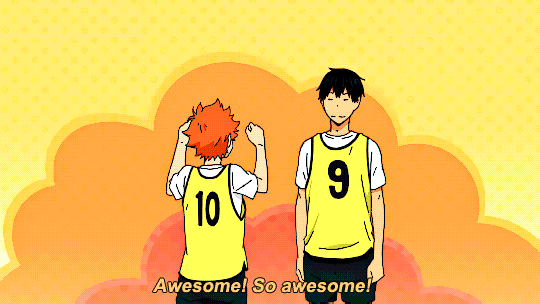

Now for his dominant functions, Kageyama primarily makes use of Ti in conjunction with Se. Kageyama is very in tune with his senses and a great deal of his thoughts are drawn from the outside world around him, he thinks about the here-and-now, definitely not dwelling on theories, intuitions, or abstract ideas and what-if’s. His Ti is revealed in his unique and individual way of thinking, something not everyone can understand and also the way he’s so passionate about volleyball? He’s always striving to improve and better himself as a player by constantly studying and analyzing and evaluating everything around him. For example, Kenma managed to earn Kageyama’s interest with his way of playing. As someone who is naturally inclined to learn and further widen their understanding (dom Ti) of volleyball, and by extension play better, his first instinct is to investigate, ask, inquire. He doesn’t notice his behavior is making Kenma uncomfortable though (weak Fe). Just, the affinity he has for the setter position is also pretty telling of dominant Ti. Kageyama is not usually talkative but when Hinata dismissed setters as boring back when they first met, he really went off lol, like I think that's the longest time he's ever spoken, or one of. Underneath that seemingly cool facade, there is a fierce passion. Dominant Ti users often dive very deeply into their interests. The setter position itself is a position that requires the player to have a lot of smarts in order to play it well. Kageyama is all about thinking up and orchestrating the plan of attack, being the “control tower of offence”, analyzing the opponents and finding their weak points, and then finally getting past their defense. He’s all about outsmarting the opponent and overcoming challenges by his own wit (very dominant Ti) which is why he loves being it so much.
Here's an example of Kageyama's use of Ti+Se:
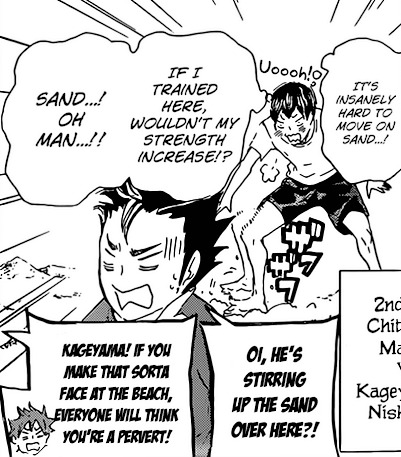
Kageyama notices how different the sand feels "It's insanely hard to move on sand!" (Se) and his mind straight away starts thinking about the implications that this new phenomenon may bring "If I trained here, wouldn't my strength increase? Sand!! Oh, man!!" (Ti). Notice that he never really vocalizes these thoughts of his.
Just… ISTJ doesn’t work because Kageyama doesn’t express inferior Ne at all, or display any dominant Si? Sure, what happened at Kitaichi really left a mark on him, but instead of it being an experience he looks upon to define the present reality in front of him, I feel like it was more of a wake up call for him to start paying attention to his weaknesses and want for his immature Fe to grow. I can't see any Fi in Kageyama either. But yes, I'm leaning away from any Si types for Kageyama because I don't think that having a past experience that deeply effects a person is indicative of dominant Si. What leads Kageyama through his life is his own personal logical framework, and his own analytical mind.
Some additional points about ISTPs that really describe Kageyama:
“[Ti] types typically do not take constructive criticism and disagreement personally. They often welcome tough, unrelenting critique as an aid to achieving the highest levels of accuracy and objectivity.”
“Others often see them as distant, unfeeling, disinterested in people, and arrogant.”
“ISTPs tend to have an interest in systems and the relationships and frameworks that make them fit together the way they do. They will pour extraordinary amounts of time into the study of these systems, but rarely through book study, never without hands-on experience…”
“Dealing with incompetence also serves as a major trigger [for emotional outbursts].”
13 notes
·
View notes
Text
My friends and I have recently gotten into playing Disney Villainous, a strategy board game where you play as the Disney Villains as you try to complete their unique objective while defeating your opponents. It’s kinda tricky and has a learning curve to it, but once you get the hang of it, it’s loads of fun. By now we’ve collectively played each villain in the original game and both expansion packs at least once, so I wanted to share my thoughts on each villain. Villains who I’ve personally played are italicized.
The Worst Takes it All
Maleficent - Maleficent was the first one I played as, and I won with her. But it was the first time we played so we all were kind of getting used to the game, so I'd probably have a harder time playing as her now that my friends are wiser about countering opponents. Maleficent has one of the most straightforward objectives: she has to start her turn with a curse cast at every location, effectively engulfing the kingdom in her dark magic. Her curses, however, can be fairly easily broken by both Fate actions and Maleficent's own actions, so you have to be very strategic with how you deploy your curses, where, and in what order. She's fun because there's a lot of genuine strategy involved with her and a challenge, but the challenge comes from the gameplay and the talent of your opponents rather than luck or a convoluted or cheap mechanic.
Jafar - Jafar is so far the only round I've played where I've straight up lost (we always play for second place with the two remaining in the game). While Jafar's deck is really visually stunning (as all are), his gameplay is less fun. His objective is that he must unlock the Cave of Wonders, and get the genie and the lamp under his control at the Sultan's Palace. The thing about Jafar is that he's basically useless until he finds the scarab to unlock the Cave of Wonders, and if it's unlucky enough to be close to the bottom of your deck (like mine was), you're in for a bad time. He's also very vulnerable to Fate actions with Aladdin and Abu's abilities to steal the lamp being a big hurdle that's very difficult to earn a win with.
Captain Hook - Hook has the reputation as the easiest villain to play as. I don't really agree with that, but he's definitely not hard. Like Jafar, Hook has the luck based difficulty of having a locked location that can only be unsealed with a single card, and, if it's at the bottom of your deck, you're in for a bad time. So many of Hook's cards are based around searching your Fate deck to find Pan, while he has very little ability to search his OWN deck (even Jafar has spells that let him dig through his). Also, because your objective to defeat Pan is so straightforward, other players see your victory coming a mile away and will soup-up Pan to make him difficult to kill. Still managed to get second place with him.
Ursula - Ursula, we've determined is the hardest and most broken character. She's also by far the most strategy heavy character. She has to get the trident and the crown to her lair, but she's very vulnerable to the luck of her deck. She's unique in that she can't defeat heroes by vanquishing them. Rather, she has to get heroes under binding contracts and fulfil the terms of the contract to defeat them, and she has to do all of this with one of her locations constantly locked (you can move the lock, but you can't break it). She also is very vulnerable to Fate actions with Ariel in particular making things impossible to win.
The Queen of Hearts - The Queen of Hearts's gameplay is based on croquet. She has to turn four card soldiers into wickets and successfully take a shot. Her board also features Wonderland size changing with her heroes able to shrink and grow to block certain actions. She has by far the most docile objective, but it's still off with the heads of her enemies. She's I'd say of a medium difficulty. She's less luck based and more arrangement based, which is interesting.
Prince John - Prince John is, I think, the easiest character and the character I think I would use to get beginners acclimated to the game. He has to accumulate 20 power tokens by taxing the people of Nottingham and farming for power. Strategy comes from being selective about which heroes you spend power to defeat and which you just move to the jail to be useless. The thing about John is that opponents see his victory coming a mile away, so you get dog piled with Fate actions the closer you get to victory. You can't really be sneaky with John.
Wicked to the Core
The Evil Queen - The one who started it all is, in my opinion, the easiest villain to win with and the most fun mechanically to play, and her gameplay borrows from Jafar, Hook, and Maleficent without ever feeling like just a rehash. The Queen wins by killing Snow White, which she must do by first casting four different potion ingredients to unlock the Dwarf's Cottage, then she must find Snow White and poison her. Most villains have to defeat heroes by sacrificing allies or playing special effect cards, but the Queen has a really fun system where she can brew her power tokens into poison tokens, and she defeats heroes by powering up her poison apples with the poison tokens. There's a more straightforward attack that the Queen has that no other villain duplicates, and with the Magic Mirror's scrying and her own effect cards, the Queen has ample opportunities to find Snow White and her potion ingredients. She's also not very heavily impeded by her Fate deck, which kind of makes her a sucker's bet to play against, but I just have such a fun time with her and her gameplay that she remains the top of my heap.
Hades - Hades is a slow march to get three Titans at Mount Olympus. They have to start at the Underworld space and cross the board. It's straightforward, but it's tedious, even more so when you consider that your Fate deck is all about freezing your Titans in place. He has some cool powers that let Hades help his Titans out and avoid discarding them like other allies, but other characters, like Scar and the Evil Queen, will leave him in the dust and win before he's even gotten one Titan in place.
Doctor Facilier - My friend played Facilier in our first game, and, ngl, I was completely lost as to what he was doing for most of the game, which is a good thing. His objective is to take over New Orleans, which he does through a special card. Facilier has to form a special deck (like Scar) and find a specific card within his deck, so it's hard to see him coming as an opponent. He seems to have the same luck-based play style that Jafar has where you're at the mercy of the shuffle of your deck.
Evil Comes Prepared
Scar - Scar is an interesting character to play because he's the most focused on destroying heroes in the plural. You have to kill Mufasa and then accumulate a special graveyard of dead heroes that adds up to a certain point value, so he has the interesting mechanic and distinction of being tricky to impede because Fating him gives him what he needs to win. He has a lot of hyenas who boost each other in numbers, which makes defeating enemies very doable. He has a sort of obnoxious Fate effect called Hakuna Matata, which resurrects dead heroes that have already been defeated (if they're under a certain level of strength) which can get annoying if you're unlucky enough to have your graveyard resting on characters like Zazu, Timon, or Pumbaa. Still, Scar is an easy villain to play as, and I enjoy the mechanics of destroying your enemies as a primary objective. Only reason I got second with Scar was because my friend was playing the Evil Queen and we were neck in neck.
Professor Ratigan - Ratigan is very item and gadget focused. He has to get the robot Mouse Queen to Buckingham Palace, however, Ratigan is unique in that if Basil defeats the robotic Mouse Queen, he goes feral and his objective becomes to kill Basil. The switching goals feature of Ratigan is fun and clever. However, the Queen Mousetoria Fate card outright blocks victory through the Robot Queen, and if she's tucked behind a wall of heroes that includes Basil the way she wound up on our playthrough, you can effectively block Ratigan from both switching objectives and from winning at all. So he's a little broken with regards to specific conditions of switching objectives and the way he can be impeded.
Yzma - Yzma has to kill Kuzco with Kronk, however she has two unique obstacles to her victory: first is that she has four different Fate decks, one for each location, which makes finding Kuzco an extra challenge. Kronk also can be redeemed into a hero under the right circumstances, which means that holding onto him until you're ready to kill Kuzco is a must. She has tough Fate actions to overcome, like Wrong Lever which costs her half her power. My friend did, however, win with her in our game.
32 notes
·
View notes
Text
Precure Day 148
Episode: Futari wa Precure Splash Star 49 - “In Top Form! Forever Friends Under the Starry Sky!” Date watched: 29 July 2019 Original air date: 28 January 2007 Screenshots: https://imgur.com/a/LingrF5? Project info and master list of posts: http://tinyurl.com/PCDabout
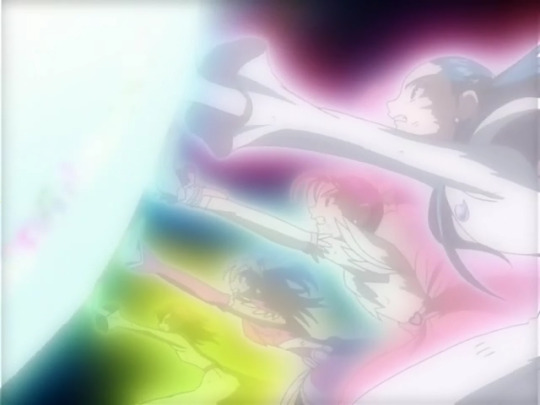
words don’t do this justice
note: I may revise this later if i look back and think of more to say. I probably will, bit i wanted to push this out now for personal reasons.
This is it. The finale. We finally made it! From November to now, Splash Star has been a long road plagued by personal difficulties and stubbornness and some lost sleep along the way, but I made it! And boy do we have a lot to discuss!
The Plot
When we left off, Saki, Mai, Michiru, and Kaoru, were infused with the power of spirits and transformed into Cures Bloom, Egret, Bright, and Windy. Gohyaan mocks their resolve and points out how all life is gone and there’s no light, no wind, nothing. It’s a world of ruin, except for the four of them, and he’s about to fix that. They battle, and as the girls again try to explain why they consider life so valuable, Gohyaan explains his backstory. He is an existence predating the universe, and he doesn’t like the commotion of life, so he wants to go back to the quiet. The girls won’t let that happen, because they have so much to live for. Gohyaan destroys the entire Earth, and thinks this is the end for them, but no! Saki explains how she needs to lead the softball team to victory. Michiru wants to try baking bread, because Saki’s is so delicious. Kaoru wants to draw with Minori and Mai, Choppi wants to live in the Land of Fountains, Flappi wants to confess his feelings, and Mai wants to keep drawing everyone’s smiles. They stand up, gather their power, and all together they perform a brand new four-person finishing attack: Precure Spiral Heart Splash Star!

This is too much for Gohyaan to handle and as the girls proclaim the strength of their hopes and futures, he is blown away.
The spirits of the various fountains and the Fairy Carafe reappear, and they restore everything to its original, beautiful state. We see all six fountains one final time, as the girls stand in front of the Sky Tree as they realize that it’s connected to the World Tree in the Land of Fountains. Princess Filia is fully restored to power, and Korone returns to being a normal, non-talking cat. However, Michiru and Kaoru have exhausted the last of their remaining energy, and they begin to fade away. Saki, Mai, Flaapi, Choppi, Moop, and Foop all cry deeply, not wanting to let their friends go, and even Filia seems sad but unable to do anything. However, a miracle occurs as the spirits of the Land of Greenery flow into the two, and Filia deduces that the spirits themselves want to live with the Michiru and Kaoru. They’re restored to life, and Princess Filia finally returns to her place in the Tree of Life.
At this point the first ending theme begins to play as we get a montage of events: All four girls visiting the Fountain of the Sky at long last, fulfilling that promise. Waving a tearful goodbye to their fairies. Mai and Kaoru drawing in school. The girls sitting on Gourd Rock in the spring. Saki and Michiru baking. And then, the softball tournament. Kaoru and Minori have drawn a picture to support Saki, while Michiru baked some bread in the shape of Saki’s head. Kaya, Miyasako, Kenta, Hitomi, Yuuko, and Mai are all in the stands anticipating the game. Saki looks into the stands and sees Izumida, the former captain, and suddenly gets nervous. She walks out of sight, and Mai walks up to her. They hold hands and Saki comments about how holding hands lets Mai’s energy flow through her, a callback to an earlier episode.
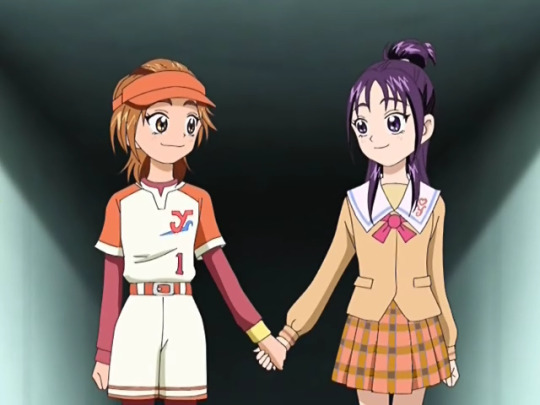
Then Saki walks out onto the field. Next thing we know, we’re treated to a few of Mai’s drawings: Saki holding the championship trophy, indicating they won. Everybody gathered together with Saki: Mai, Michiru, Kaoru, Kenta, Miyasako, Kaya, Hitomi, Yuuko, Izumida, Ms. Shinohara, Saki’s parents, Mai’s parents, Minori, Kazuyua, Korone, and all the fairies. Basically, every major character in the series. How nobody saw the fairies is not answered, and I have to assume it’s actually a photograph that Mai copied but details aside, it’s a great picture.
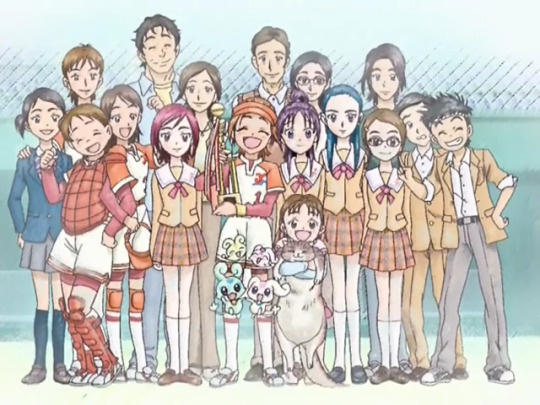
We zoom out to see Saki and Mai sitting beneath the Sky Tree, closing the sketchbook, and the real credits roll.
The Analysis
I absolutely love every minute of this. Even with the powers of all four spirits, Gohyaan is a formidable opponent, but the girls hold their own and manage to overcome him in the end. What is the power of destruction next to an indestructible will? He underestimates the power, the value, of life, and that is his ultimate undoing. He gets the peace and quiet he wants.... at the cost of his existence. And, indeed, this explains the Uzainaa’s name. It’s derived from “Urusai na”, which means “it’s annoying”. Gohyaan is an existence that predates the universe, and he doesn’t like the commotion created by life. It’s a darkly mundane reason to want to try to destroy everything, and frankly he should find a new hobby, but maybe in the end he learned that life is precious. Doesn’t seem like it, though. Honestly I don’t have much to say about the battle itself. There’s some good scenes, like this part where the cures all flip Gohyaan, but it’s more of an exchange of wills than a physical fight. Both are important aspects, as I’ve commented many times, I just want to note that the physical stuff was done last episode.
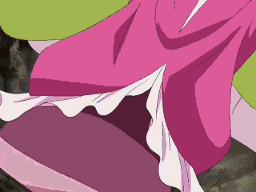
Let’s talk Michiru and Kaoru. Officially, they don’t get new designations even with the powers of Moon and Wind, because the idea at the time was still that Precures were only ordinary girls, but I think they deserve to be called Cure Bright and Cure Windy. Their journey is heartbreaking, even if their death was an inevitability and they were given a new lease on life very quickly. They never deserved what they got, but their tragedy is a part of this show I honestly forgot about, and I think it makes it more powerful. I knew Splash Star was an underrated gem but I had forgotten the depths of tragedy the Kiryuus were in, I kind of thought everything was pretty hunky-dory when they got back. Their journey escalates this show to a higher tier in my view, and I’ll have to remember that when making recommendations.
Obviously, they already had powers from being Dark Fall denizens, and getting Cure abilities doesn’t make them innately better, but it’s a great next step for them, epitomizing the journey they’ve undergone from mindless servants of Akudaikaan to friends and sisters who have a network of people who care about and support them, discovering their own interests, and getting to live life. They are every inch heroes in the way that Saki and Mai are and they have been done dirty by the franchise writ large.
The epilogue gives us a lot of things I really wanted. Michiru and Kaoru finally get some casual clothes, and they are really stylish.
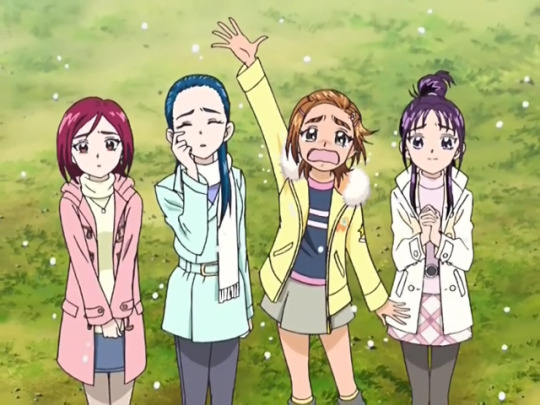
Also, we fast forward to spring and see them in spring outfits and Michiru’s outfit is extremely similar to Nagisa’s spring clothes.
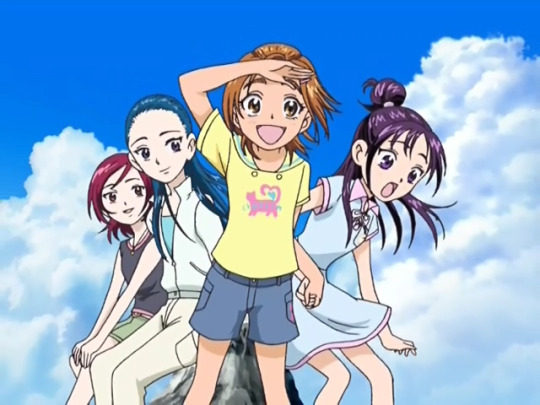
I’m happy to see them living normal lives, practicing baking and art and getting to experience life, finally. They seem so happy and I’m sure they have a bright future ahead of them and GOD DAMN IT TOEI WHY DO YOU IGNORE THEM. They were lucky to get Figuarts.
The softball championship game is something else I honestly forgot happened. I commented back in the last softball episode (35 I think) that we would never see Saki lead the team to victory the next year, because the show didn’t get a second season. Well, they took care of that here, and Saki did live up to her promise to Izumida by winning the championship.

In general it’s a lot of tying up loose ends that I really appreciate. Flappi finally confessed his feelings to Choppi and they’re a couple now, Kenta and Miyasako are still going strong as a manzai duo, Yuuko feels inspired by his encouragement even if they don’t seem to be a couple, and... well, the last closure we got on Saki and Kazuya was in the Christmas episode, but that’s just as well because Saki’s only love is Mai. For real though I love that the episode closes out on them being close, and you can choose to interpret their friendship any way you choose. It’s just perfect for this show.
Oh and there’s a little epilogue after the ending theme. On the TV broadcast it was probably a preview for Yes! 5, but we don’t get that here. Instead we get , some stills of Saki and Mai thanking everybody for watching, and saying that Precure will continue for a long time! And boy, truer words were never spoken.

Next time on precure Daily, I’m going to revisit a little Splash Star something that I forgot to do sooner. After that, I’m going to try to push out a retrospective on the entire Futari wa era, before we change up the formula big time with Yes 5. My goal is to finish Yes 5 by the end of 2019, but if I’m really good I might even be able to start GoGo this year. I don’t want to drag another show out for 8 months, so we’ll see where we end up. I hope to see all of you again soon!
Pink Precure Catchphrase Count: 1 Zekkouchou Nari!, in the title of the episode.
16 notes
·
View notes
Text
GOTY 2019
I wanted to write a personal Game of the Year list, but I realized I really didn’t play that many games that were new in 2019. So I’m ranking them, but it’s less a “top 10” and more a “10 games I played and how I felt about them.”
10. Kingdom Hearts III
Kingdom Hearts III plays like a game from 2005.
I’m not sure I can fully articulate what I mean by that. Maybe I mean its combat is largely simplistic and button-mashy. Maybe I mean its rhythms of level traversal and cutscene exposition dumps are archaic and outdated. Maybe feeling like this game is a relic from another time is unavoidable, given how many years have passed since its first series entry.
But there’s also something joyful and celebratory about it all — something kind of refreshing about a work that knows only a tiny portion of its players will understand all its references and lore and world-building, and just doesn’t care.
Despite all the mockery and memery surrounding its fiction, Kingdom Hearts’ strongest storytelling moments are actually pretty simple. They’re about the struggle to exist, to belong, and to define what those things mean for yourself. I think that’s why the series reaches the people it does.
Those moments make Kingdom Hearts III worth defending, if not worth recommending.
9. Sekiro: Shadows Die Twice
Admittedly, I only played about 10-15 hours of this in 2019. Perhaps fittingly, that’s about the amount of time I originally spent on Dark Souls when it released in 2011. I bounced off, hard, because I didn’t understand what it was asking of me. Once I did — though, it has to be said, I needed other people to explain those expectations to me, because the game sure as hell didn’t — Dark Souls became an all-time favorite. And I’ve played every FromSoft game since then, and enjoyed them all. Until Sekiro.
Part of it is, again, down to expectation. Dark Souls trained its players on a certain style of combat: cautious movements, careful attention to spacing, committing to weighty attacks, waiting for counterattacks. In every game since then, FromSoft have iterated on those expectations in the same direction in an attempt to encourage players to be less cautious and more aggressive. The series moved from tank-heavy play in Dark Souls, to dual-wielding in DS2, to weapon arts and reworking poise in DS3, to the system of regaining health by attacking in Bloodborne.
In some ways, Sekiro is a natural continuation of this trend toward aggression, but in others, it’s a complete U-turn. Bloodborne eschewed blocking and prioritized dodging as the quickest, most effective defensive option. Sekiro does exactly the opposite. Blocking is always your first choice, parrying is essential instead of largely optional, and dodging is near useless except in special cases. FromSoft spent five games teaching me my habits, and it was just too hard for me to break them for Sekiro.
I have other issues, too — health/damage upgrades are gated behind boss fights, so grinding is pointless; the setting and story lack some of the creativity of the game’s predecessors; there’s no variety of builds or playstyles — but the FromSoft magic is still there, too. Nothing can match the feeling of beating a Souls-series boss. And the addition of a grappling hook makes the verticality of Sekiro’s level design fascinating.
I dunno. I feel like there’s more here I’d enjoy, if I ever manage to push through the barriers. Maybe — as I finally did with the first Dark Souls, over a year after its release — someday I will.
8. Star Wars Jedi: Fallen Order
In December, my wife and I traveled to Newport Beach for a family wedding, and we stayed an extra day to visit Disneyland. As an early birthday present, Aubrey bought me the experience of building a lightsaber in Galaxy’s Edge. And the experience is definitely what you’re paying for; the lightsaber itself is cool, but it’s cool because it’s made from parts I selected, with a blade color I chose, and I got to riff and banter with in-character park employees while doing it. (“Can you actually read those?” one asked me in an awed voice, when I selected a lightsaber hilt portion adorned with ancient Jedi runes. “Not yet,” I told her. “We’ll see if the Force can teach me.”)
Maybe it’s because I just had that experience, but by far my favorite moment in Jedi: Fallen Order is when main character Cal Kestis overcomes his own fears and memories to forge his own lightsaber, using a kyber crystal that calls to him personally. It’s maybe the only part of the game that made me feel like a Jedi, in a way the hours of Souls-inspired lightsaber slashing didn’t.
I think that’s telling. And I think it’s because so much of Fallen Order is derivative of other works, both in the current canon of gaming and of Star Wars. That’s not to say it’s bad — the mélange of Uncharted/Tomb Raider traversal, combat that evokes Souls and God of War, and vaguely Metroid-y power acquisition and exploration mostly works — but it’s just a titch less than the sum of those parts.
Similarly, as a Star Wars story, it feels under-baked. There’s potential in exploring the period immediately after Order 66 and the Jedi purge, but you only see glimpses of that. And I understand the difficulty of telling a story where the characters succeed but in a way that doesn’t affect established canon, but it still seemed like there were a couple of missed opportunities at touching base with the larger Star Wars universe. (And the one big reference that does pop up at the end feels forced and unrealistic.)
When I got home from California, I took my lightsaber apart just to see how it all worked. Outside of the hushed tones and glowing lights of Savi’s Workshop, it seems a little less special. It’s still really cool…but I sort of wish I had had a wider variety of parts to choose from. And that I had bought some of the other crystal colors. Just in case.
That’s how I feel about Jedi: Fallen Order. I had fun with it. But it’s easier now to see the parts for what they are.
7. Untitled Goose Game
Aubrey and I first saw this game at PAX, at a booth which charmingly recreated the garden of the game’s first level. We were instantly smitten, and as I’ve introduced it to family and friends, they’ve all had the same reaction. When we visited my brother’s family in Florida over the holidays, my eight-year-old niece and nephew peppered me with questions about some of the more complex puzzles. Even my father, whose gaming experience basically topped out at NES Open Tournament Golf in 1991, gave it a shot.
I’m not sure I have a lot more to say here, other than a few bullet points:
1) I love that Untitled Goose Game is completely nonviolent. It would’ve been easy to add a “peck” option as another gameplay verb, another means of mischief. (And, from what I understand, it would be entirely appropriate, given the aggression of actual geese.) That the developers resisted this is refreshing.
2) I’m glad a game this size can have such a wide reach, and that it doesn’t have to be a platform exclusive.
3) Honk.
6. Tetris 99
Despite the number of hours I’ve spent playing games, and the variety of genres that time has spanned, I’m not much for competitive gaming. This is partially because the competitive aspect of my personality has waned with age, and partially because I am extremely bad at most multiplayer games.
The one exception to this is Tetris.
I am a Tetris GOD.
Of course, that’s an incredible overstatement. Now that I’ve seen real Ecstasy of Order, Grandmaster-level Tetris players, I realize how mediocre I am. But in my real, actual life, I have never found anyone near my skill level. In high school, I would bring two Game Boys, two copies of Tetris, and a link cable on long bus rides to marching band competitions, hoping to find willing challengers. The Game Boys themselves became very popular. Playing me did not.
Prior to Tetris 99, the only version of the game that gave me any shred of humility in a competitive sense was Tetris DS, where Japanese players I found online routinely handed me my ass. I held my own, too, but that was the first time in my life when I wasn’t light-years beyond any opponent.
As time passed and internet gaming and culture became more accessible, I soon realized I was nowhere near the true best Tetris players in the world. Which was okay by me. I’m happy to be a big fish in a small pond, in pretty much all aspects of my life.
Tetris 99 has given me a perfectly sized pond. I feel like I’m a favorite to win every round I play, and I usually finish in the top 10 or higher. But it’s also always a challenge, because there’s just enough metagame to navigate. Have I targeted the right enemies? Do I have enough badges to make my Tetrises hit harder? Can I stay below the radar for long enough? These aspects go beyond and combine with the fundamental piece-dropping in a way I absolutely love.
The one thing I haven’t done yet is win an Invictus match (a mode reserved only for those who have won a standard 99-player match). But it’s only a matter of time.
5. Pokemon Sword/Shield
I don’t think I’ve played a Pokemon game through to completion since the originals. I always buy them, but I always seem to lose steam halfway through. But I finished Shield over the holidays, and I had a blast doing it.
Because I’m a mostly casual Pokeplayer, the decision to not include every ‘mon in series history didn’t bother me at all. I really enjoyed learning about new Pokemon and forcing myself to try moving away from my usual standards. (Although I did still use a Gyarados in my final team.)
As a fan of English soccer, the stadium-centric, British-flavored setting also contributed to my desire to see the game through. Changing into my uniform and walking onto a huge, grassy pitch, with tens of thousands of cheering fans looking on, really did give me a different feeling than battles in past games, which always seemed to be in weird, isolated settings.
I’m not sure I’ll push too far into the postgame; I’ve never felt the need to catch ‘em all. But I had a great time with the ones I caught.
4. The Legend of Zelda: Link’s Awakening
I have a strange relationship with the Zelda series, especially now. They are my wife’s favorite games of all time. But I don’t know if I’ve ever actually sat down and beaten one since the original Link’s Awakening. Even with Breath of the Wild, which I adore, I was content to watch Aubrey do the heavy lifting. I know the series well, I’ve played bits of all of them, but most haven’t stuck with me.
Link’s Awakening has. I wrote a piece once about its existential storytelling and how it affected me as a child. I love the way the graphics in this remake preserve that dreamlike quality. It’s pretty much a re-skin of the original game, but the cutesy, toy-set aesthetic pairs well with the heavy material. If this is all a dream, whose dream is it? And when we wake up, what happens to it?
Truthfully, some of the puzzles and design decisions haven’t held up super well. Despite the fresh coat of paint, it definitely feels like a 25-year-old game. But I’m so glad this version exists.
Oh, and that solo clarinet in the Mabe Village theme? *Chef’s kiss*
3. Control
I actually haven’t seen a lot of the influences Control wears on its sleeve. I’ve never gone completely through all the episodes of the X-Files, Fringe, and Twin Peaks; I’m only vaguely familiar with the series of “creepypasta” fiction called SCP Foundation; and I have never endeavored to sit through a broadcast of Coast to Coast AM. I’m also unfamiliar with Remedy’s best-known work in the genre, Alan Wake. But I know enough about all those works to be able to identify their inspiration on the Federal Bureau of Control, Jesse Faden, and the Oldest House.
Control is an interesting game to recommend (which I do), because I’m not sure how much I really enjoyed its combat. For most of the game, it’s a pretty standard third-person shooter. You can’t snap to cover, which indicates you’re intended to stay on the move. This becomes even more obvious when you gain the ability to air dash and fly. But you do need to use cover, because Jesse doesn’t have much health even at the end of the game. So combat encounters can get out of hand quickly, and there’s little incentive to keep fighting enemies in the late game. Yet they respawn at a frustratingly frequent rate. The game’s checkpointing system compounds this — you only respawn at “control points,” which act like Souls-style bonfires. This leads to some unfortunately tedious runbacks after boss fights.
On the other hand, Jesse’s telekinesis power always feels fantastic, and varying your attacks between gunshots, thrown objects, melee, and mind controlling enemies can be frenetic fun. That all comes to a head in the game’s combat (and perhaps aesthetic?) high point, the Ashtray Maze. To say more would be doing a disservice. It’s awesome.
The rest of the gameplay is awesome, too — and I do call it “gameplay,” though unfortunately you don’t have many options for affecting the world beyond violence. The act of exploring the Oldest House and scouring it for bureaucratic case files, audio recordings, and those unbelievably creepy “Threshold Kids” videos is pure joy. The way the case files are redacted leaves just enough to the imagination, and the idea of a federal facility being built on top of and absorbed into a sort of nexus of interdimensional weirdness is perfectly executed. And what’s up with that motel? And the alien, all-seeing, vaguely sinister Board? So cool.
With such great worldbuilding, I did wish for a little more player agency. There are no real dialogue choices — no way to imbue Jesse with any character traits beyond what’s pre-written for her — and only one ending. This kind of unchecked weird science is the perfect environment for forcing the player into difficult decisions (what do we study? How far is too far? How do we keep it all secret?), and that just isn’t part of the game at all. Which is fine — Control isn’t quite an immersive sim like Prey, and it’s not trying to be. I just see some similarities and potential, and I wish they had been explored a little.
But Control’s still a fantastic experience, and in any other year, it probably would’ve been my number one pick. That’s how good these next two games are.
2. Outer Wilds
Honestly, this is the best game of 2019. But I’m not listing it as number one because I didn’t play most of it — Aubrey did. Usually we play everything together; even if we’re not passing a controller back and forth, one of us will watch while the other one plays. And that definitely happened for a large chunk of Outer Wilds. But Aubrey did make some key discoveries while I was otherwise occupied, so while I think it’s probably the best game, it’s not the one I personally spent the most time with.
The time I did spend, though? Wow. From the moment you wake up at the campfire and set off in search of your spaceship launch codes, it’s clear that this is a game that revels in discovery. Discovery for its own sake, for the furthering of knowledge, for the protection of others, for the sheer fun of it. Some games actively discourage players from asking the question, “Hey, what’s that over there?” Outer Wilds begs you to ask it, and then rewards you not with treasure or statistical growth, but with the opportunity to ask again, about something even more wondrous and significant.
There are so many memorable moments of discovery in this game. The discovery that, hey, does that sun look redder to you than it used to? The discovery that, whoa, why did I wake up where I started after seemingly dying in space? Your first trip through a black hole. Your first trip to the quantum moon. Your first trip to the weird, bigger-on-the-inside fog-filled heart of a certain dark, brambly place. (Aubrey won’t forget that any time soon.)
They take effort, those moments. They do have to be earned, and it isn’t easy. Your spaceship flies like it looks: sketchy, taped together, powered by ingenuity and, like, marshmallows, probably. Some of the leaps you have to make — both of intuition and of jetpack — are a little too far. (We weren’t too proud to look up a couple hints when we were truly stuck.) But in the tradition of the best adventure games (which is what this is, at heart), you have everything you need right from the beginning. All you have to do is gather the knowledge to understand it and put it into action.
And beyond those moments of logical and graphical discovery, there’s real emotion and pathos, too. As you explore the remnants of the lost civilization that preceded yours, your only method of communication is reading their writing. And as you do, you start to get a picture of them not just as individuals (who fight, flirt, and work together to help each other), but as a species whose boundless thirst for discovery was their greatest asset, highest priority, undoing, and salvation, all at once.
I don’t think I can say much more without delving into spoilers, or retreading ground others have covered. (Go read Austin Walker’s beautiful and insightful review for more.) It’s an incredible game, and one everyone with even a passing interest in the medium should try.
(Last thing: Yes, I manually flew to the Sun Station and got inside. No, I don’t recommend it.)
1. Fire Emblem: Three Houses
If I hadn’t just started a replay of this game, I don’t think I’d be listing it in the number one slot. I started a replay because I showed it to my brother when we visited him in Florida last month, and immediately, all the old feelings came flooding back. I needed another hit.
No game this year has been as compelling for me. That’s an overused word in entertainment criticism, but I mean it literally: There have been nights where I absolutely HAVE to keep playing (much to Aubrey’s dismay). One more week of in-game time. One more study session to raise a skill rank. One more meal together so I can recruit another student. One more battle. Just a little longer.
I’m not sure I can put my finger on the source of that compulsion. Part of it is the excellence of craftsmanship on display; if any technical or creative aspect of Three Houses was less polished than it is, I probably wouldn’t feel so drawn to it. But the two big answers, I think, are the characters and their growth, both mechanically and narratively.
At the start of the game, you pick one of the titular three houses to oversee as professor. While this choice defines who you’ll have in your starting party, that can be mitigated later, as almost every other student from the other two houses can be recruited to join yours. What you’re really choosing is which perspective you’ll see the events of the story from, and through whose eyes: Edelgard of the Black Eagles, Dimitri of the Blue Lions, or Claude of the Golden Deer. (This is also why the game almost demands at least three playthroughs.)
These three narratives are deftly written so you simultaneously feel like you made the only possible canonical choice, while also sowing questions into your decision-making. Edelgard’s furious desire for change is just but perhaps not justifiable; Dimitri hides an obsession with revenge behind a façade of noblesse oblige; Claude is more conniving and pragmatic than he lets on. No matter who you side with, you’ll eventually have to face the others. And everyone can make a case that they, not you, are on the right side.
This is especially effective because almost every character in Three Houses is dealing with a legacy of war and violence. A big theme of the game’s story is how those experiences inform and influence the actions of the victims. What steps are justified to counteract such suffering? How do you break the cycle if you can’t break the power structures that perpetuate it? How do good people end up fighting for bad causes?
While you and your child soldiers (yeah, you do kind of have to just skip over that part; they’re in their late teens, at least? Still not good enough, but could be worse?) are grappling with these questions, they’re also growing in combat strength, at your direction. This is the part that really grabbed me and my lizard brain — watching those numbers get bigger was unbelievably gratifying. Each character class has certain skill requirement prerequisites, and as professor, you get to define how your students meet those requirements, and which they focus on. Each student has certain innate skills, but they also have hidden interests that only come to the surface with guidance. A character who seems a shoo-in to serve as a white mage might secretly make an incredibly effective knight; someone who seems destined for a life as a swordsman suddenly shows a talent for black magic. You can lean into their predilections, or go against them, with almost equal efficacy.
For me, this was the best part of Three Houses, and the part that kept me up long after my wife had gone to bed. Planning a student’s final battle role takes far-seeing planning and preparation, and each step along the way felt thrilling. How can you not forge a connection with characters you’ve taken such pains to help along the way? How can you not explode with joy when they reach their goals?
That’s the real draw of Fire Emblem: Three Houses, I think: the joy of seeing people you care about grow, while simultaneously confronting those you once cared about, but who followed another path. No wonder I wanted to start another playthrough. I think I’ll be starting them all over again for a long time.
1 note
·
View note
Text
My Dragonball Z reboot
Dragon ball is another one of those big awesome anime series that just didn’t know when to quit. Like many others, rather than go out on a high note, they just keep going and going, regardless of the drop in quality. I for one don’t really care for dragon ball super. So, here is the concept for a total reboot of the dragon ball series. The style would be similar to that of dragonball z, and the setting/world is the same: with earth being the same mishmash of eras of time and cultures. The main alteration to this reality is that planet vegeta and the saiyans still exist. This breakdown will be a bit vague because I do not have any names for the characters. To keep things simple for now and consistent with the franchise trends, i will give them temporary stand in names.
ARC 1
Two saiyans, a brother(carrot) and sister(cabbage), land on earth with the missions to raise it. They split up and cabbage meets a human(tech); a young man inventor with some martial arts training. Making her intentions clear, he challenges her, knowing he has little chance of winning. Though she consistently beats him severely, he refuses to stay down. After letting her take a rest, he uses a technicality of their agreement (her being on the ground for 10 seconds) to declare victory. Initially furious, she becomes amused, respecting him and concedes. The two become fast friends and, impressed by earth’s food and beauty, she begins to decide she does not want to destroy the planet. Meanwhile carrot amuses himself with mischief and destruction. Returning, the siblings clash in a fierce battle which she wins, and carrot, badly injured, spitefully sends a message through his scouter for saiyan back up before escaping.
Tech is told of the saiyans mission of conquering planets in reluctant servitude of the space tyrant, king frieza. Tech reveals he has one of the legendary dragon balls as a family heirloom and if they collect all 7, they can wish for the earths safety. With practice, cabbage realizes she can detect the unique energy of the dragon balls and they set out across the world to find them. A healed carrot learns of their intentions and sets out for the balls as well, desiring invincibility. Tech and carrot have many adventures in their search for the balls, including an ongoing feud with an underground militia of sentient machines who desire world conquest. A romantic tension between them begins to build and they also come to meet the hidden alien guardian of the earth, kami and become quick enemies with his evil counterpart piccolo. They also gain a dragon ball from a Martial arts master after first defeating his 3 guards then him. Impressed and recognizing cabbages potential outside of just her raw power, he offers to train them. They accept but will only return after they have made their wish.
They gain all but one ball, which carrot has retrieved. Confronting each other again, the battle turns to wide spread carnage when the moon rises and both transform to battle in their great ape forms. Needing to end the threat, tech severs both their tails, and when carrot attacks civilians in a last act of desperation, cabbage is forced to deal a killing blow. Reconciling with his sister as he dies, he tells her that they have at least 2 years before the other saiyans are likely to come. Both tech and cabbage agree to use the dragons wish to undo the damage done by the battle. Building a clock to count down until the dragon balls will be usable again, the two return to the master to train.
ARC 2
Training under their hardy master and black, his strict niece/assistant, both have shown great improvement in their fighting skills, as well as more open signs of feelings for each other. With nothing left to learn, they are dispatched far and wide to do odd ball tasks for their master. Eventually, he reveals that due to financial difficulties, he intends for them to represent his dojo in the world’s martial arts tournament. They do and face many opponents and win. However, the semi-final has them battling each other. After a long match that sees many feelings and insecurities brought to the surface, cabbage ultimately wins. She faces the final opponent, revealed to be a disguised piccolo. After a brutal match in which both resort to using their energy attacks, she seemingly destroys piccolo and wins the tournament. She and tech reconcile and admit they love each other and begin a relationship. As a show of love he gathers the dragon balls and wishes cabbages tail back.
ARC 3
Before the dragon balls can renew again, cabbage, tech and their allies, now called the Z fighters, are summoned by kami. Revealing that the saiyans are on their way and will arrive sooner than expected, he intends to train them in special new techniques to better stand against the saiyans’ powers. During their training, they also learn of the history of the saiyans as well as of kamis race. Eventually the z fighters head for the desert in hopes of keeping the fight away from populated areas. A squad of 5 saiyans arrives, including an old friend of cabbage and led by the psychotic saiyan prince broly. Broly declares her a traitor but chooses to sit and watch as the others fight. A massive battle erupts between the groups in which two of the saiyans are killed but the master is badly wounded and all but cabbage and tech leave to take him to heal. All of this is also witnessed by piccolo from afar, who takes an interest in broly.
The moon rises and cabbage and the two other saiyans transform and do battle as great apes all through the night. She manages to kill one but chooses to spare her friend. Broly finally enters the battle and is the stronger as he beats her. Summoning as much ki as he can muster, tech manages a single punch to broly, scarring and briefly disorienting him. His hand now shattered and with no energy left, tech can only smugly accept his fate as broly angrily delivers a fatal blow. Driven made by grief, cabbage is transformed into a legendary super saiyan, while her friend takes tech to safety. Despite unleashing his full power and going into a battle craze, broly is beaten to within an inch of his life and left for dead. Unknown to the others, he is rescued by piccolo, who returns him to his ship and maintains that he is an ally. Cabbage and tech declare their love as he dies, but he reminds her that she can bring him back with the dragon balls and she promises to. Her friend declines to stay on earth and leaves to rejoin their race.
ARC 4
While cabbage deals with loss and boredom in the living world, techs soul appears at a cross road between heaven and hell. A middle road appears to him and a voice leads him down it to a small world. There he is greeted by the great king kai, who intends to train him so he will be stronger when he is brought back to life. It is revealed that carrot is also there being trained by the kai. Though there is initial hostility, the two grow closer through their training and become somewhat more civil. With the dragon balls active again, cabbage is in a race against piccolo to retrieve them. After all have been found by one or the other, they fight for all 7. Piccolo wins but the dragon cannot grant his wish of immortality, as he is technically still a part of kami, and the dragon cannot grant his own creator a wish. While piccolo angrily attacks the dragon, cabbage is telepathically informed by king kai to phrase her wish a certain way. She steals the wish in the confusion, which results in reviving tech and carrot. Syphoning some of the dragons power before he vanishes again, piccolo empowers himself and battles the three, who ultimately defeat him, but are warned not to kill him for fear of killing kami. Piccolo is instead imprisoned beneath the dojo.
A brief time jump shows that tech and cabbage are married and she is pregnant and they have moved into a house connected to their master’s dojo. Carrot has also joined them, now having a love/hate relationship with black. They take part in a celebration and competition between many of the regional martial arts dojos.
ARC 5
8 years later, tech and cabbage act as instructors for the now more popular dojo, with their half saiyan twin son and daughter among their students. Carrot and black are also together and have 2 sons. As their anniversary nears, cabbage finds herself teleported to king kais world, who warns of a great threat heading to earth. He teaches her many powerful new techniques, primarily the spirit bomb. Sending her back, she and tech celebrate their anniversary before the earth comes under invasion; king frieza has arrived. The Z fighters fight friezas forces across multiple locations and skirmishes until frieza and a healed broly arrive, along with cabbages friend, now a brain washed cyborg. Broly and carrot clash in a furious battle, with both reaching super saiyan forms and fighting to a standstill. Tech battles the cyborg saiyan but is beaten, but she is then overwhelmed and beaten by the half saiyan children.
Cabbage battles with frieza but cannot overcome him and transforms into a super saiyan. Frieza absorbs the kai of his forces, killing them but making him giant and more powerful. Using her knowledge of earth to her advantage, the moon rises and she becomes a super saiyan great ape. Now more evenly matched, they engage in a titan sized battle that destroys the land scape. By dawn cabbage reverts to normal and a beaten and humiliated, frieza prepares a blast to destroy all of earth and intends to do the same to the saiyans home world Vegeta. Hearing this, broly furiously attacks him, thwarting the attack. Using the opening, cabbage charges a spirit bomb and blasts frieza into space and his apparent death. Broly escapes in the chaos and vows to return with the whole saiyan army.
In the aftermath, the z fighters return home with the cyborg saiyan, who appears to be free of her brainwashing. They locate the dragon balls again and finally use their wish to protect earth, making it invisible to any who mean it harm. This is just in time as broly returns with his forces but cannot locate the planet. Embarrassed, he is also belittled and ordered back to planet vegeta by his father king paragus to answer for his betrayal of frieza, who is revealed to have survived. On earth, the cyborg saiyan is briefly taken over by a preprogrammed order and silently slips away and frees piccolo, giving him a special task from broly.
ARC 6
1 year after the defeat of frieza, tech, cabbage, carrot and black leave to take part in the next world martial arts tournament. While they are gone, piccolo returns and battles the dojo master, with the cyborgs conditioning keeping her from interfering. Piccolo wins and kidnaps the 4 half saiyan children, per brolys request. Their parents return and are told by the cyborg that piccolo has taken them to planet vegeta. Before they leave on a ship salvaged from friezas invasion, they are summoned by kami. Knowing that piccolo must be destroyed, he names the dojo master as his successor and gives each of the fighters a portion of his power. They leave and briefly stop on namik, kamis home world. They train in new techniques, resupply and learn of a single renegade warrior, who sought redemption by splitting his good and evil halves, forming kami and piccolo. The cyborg, thinking herself a liability, chooses to stay on namik and mentally train to overcome her conditioning.
Arriving on vegeta, they learn that broly has killed his father and become king and is in the midst of a battle with friezas empire. They infiltrate vegeta only to discover broly, with piccolo, and a cyborg freiza striking a truce. They reveal the half saiyan children, now brainwashed, and have them attack their parents. After some time, the parents use the mental abilities they learned on namik to reach the children and free them. An all-out brawl soon erupts; cabbage fighting broly, carrot fighting frieza, tech and black fighting piccolo and the children and the z fighters fighting broly/friezas henchman. The rest of the saiyans, convinced by the returned cyborg to rebel against broly, renew their fight against freizas forces. Both frieza and piccolo are killed in the respective battles, and on earth, the master bids a sad farwell to kami as he dies. Their battle having taken them to a nearby barren world, broly and cabbage are evenly matched as super saiyans. Broly absorbs all the ki of freizas forces, destroying his whole army and transforming into the super saiyan god form. Cabbage is able to achieve the same with the ki willingly given by her family, friends and the other saiyans. She manages to win the fight by blasting broly into the sun with a spirit bomb, killing him.
In the aftermath, the cyborg becomes the new queen of vegeta and the others enjoy a vacation there before returning to earth. A nemikian joins them so as to aid the master and repower the dragon balls. Cabbage and tech also take over as masters for the dojo.
ARC 7
6 years later, the half saiyan children are deal with high school and mundane life while keeping their considerable power under wraps. The Z fighters are forced to again contend with the return of the machine militia, as well as the vengeful brother of freiza, cooler. Cooler however is more honorable and relents after accepting the necessity of his brothers death. The earth soon faces a new threat of the dark kai, a demonic former kai who sought cosmic destruction. Joined by cooler, the z fighters infiltrate his demonic fortress, with it taking all the saiyans together to overwhelm and destroy him.
King kai invites the fighters to the otherworldly realm and asks them to represent him in a fighting tournament of beings from across the universe. The fighters compete until cabbage and carrot stand as the finalist team, and are set to face the spirits of piccolo and broly, the champions of the lord of hell. Both sides eagerly prepare to battle, eager for a rematch.
The end.
2 notes
·
View notes
Text
Research Into Similar Products: Souls games

Even though the dark souls (FromSoftware, 2011) games aren’t in the same genre as our game in terms of mechanics, i still believe it will be useful to research into this product for the psychological effects of a difficult game on players.
Being renowned for being relentless and unforgiving, dark souls brought back what classical gaming used to be like with difficult to master mechanics and incredibly hard game-play. The way the game is designed to test the players at every interval of the game and not just at the bosses removes the monotony from common everyday games, players have to be constantly aware as even the most common enemy can prove a worthy opponent if not approached properly. Of course this comes with its ups and downs, because of the difficulty and the fact that the player has to have a pretty good willpower to constantly get knocked down and keep getting back up, it alienates anyone that finds the game too difficult to play or doesnt enjoy a game that makes them have to work really hard to complete it. FromSoftware obviously knew that this would be the case and implemented in a feature to summon in other players and NPC’s to help you to, and to defeat, the boss. This allows less hardcore players to experience the game without the torment of being alone, of course the player will still need a little skill to get them through so you cant just get someone to complete the game for you, they will be able to experience some of what the solo game has to offer the way FromSoftware intended.

- An example of someone not approaching the most basic enemies with the proper strategy resulting in an embarrassing death.
I wanted to play about with this difficulty mechanic in a rogue like game because generally that is how they are layed out; you progress as far as you can unlocking new items and such and when you die you restart and try again. A little simpler than dark souls but in the same breadth. I need to think carefully about how i plan this though as i dont want players to feel like what they are playing is impossible to beat, and that is something dark souls does well, it gives the player all the necessary ingredients to beat an area/boss and all they have to do is put them together and win. In my game i need to give players items or develop the game in a way that entices the player to want to find out more about the game and if they die they are going to have to want to get back to that point or they just wont bother playing the game again.


- The death screens for two completely different rogue like games, notice the similarities? Both say what character you played as, both say what section of the game you died in, both have the items you had upon death, both have what killed you and, most importantly, both have an easy way to restart the game and exit to the main menu. This clearly shows how games of this genre deal with dying, summarising the players journey in that run and giving them an easy way to start again making it so the player doesn't have to go to any effort going through menus to restart the game, insentivising continuous runs. This is something i will definitely look to implementing into my game as i want to clearly communicate to the audience that the aim of the game is to keep getting better as you play, it isn't trying to overcome an impossible task, and by showing the players progress every time they die they can see their progress and if a new strategy is working or not.
Another thing i have to consider is the level of player playing the game, some players are going to want to enjoy the game without having to struggle through it or maybe they want to struggle but not have their progress reset every time they die, so i thought about implementing a difficulty mechanic that alters things like enemy and player health and damage, and also a mechanic where the player can save their game or select a level once they have unlocked it, similar to the way Dark Souls lets you revisit levels by travelling to bonfires (once you unlock the teleport ability in the first game but it is standard in the later games) or how Enter The Gungeon has a button after every boss that lets you save and exit the game if you need a break.


- the bonfire (top) from Dark Souls, and the save button NPC (bottom) in Enter the Gungeon. It is interesting to note that the save button was added in late after release because the community recommended it as players found it difficult to put the game down and not receive a penalty for doing so, this is valuable information to use in our game as it is clear that players want a way to save their progress without fear of losing it so that they can leave and come back.

- A review of the game before the save function was added, adding in the save button effectively made this a flawless game in critics eyes.
1 note
·
View note
Text
Esoteric Gaming Jargon
In our hobby and industry, there are quite a few terms of jargon tossed about. Not all of them are specific or unique to tabletop gaming, but for enough of them we gamers have our own definitions. Someone new to RPGs might need a little guidance on understanding what we’re saying when we drop some of these terms.
About ten years ago, Walt put together an RPG glossary here on Gnome Stew. This list is by no means a replacement, but, rather, an appendix to his wonderful and in-depth article. I’m not going to cover the basics like GM, PC, NPC, etc.. Walt’s glossary does a wonderful job of this already.
This post will be a little long in the tooth because of the number of terms I’m going to lay down on you, so I’m just going to jump in the list. Also, I tried to group the definitions together in a way that made sense instead of alphabetically.
Grognard – French for “grumbler.” An old soldier. I suppose grumbler and old soldier can be synonymous. In the RPG world, we use it to describe folks who enjoy older RPGs as opposed to the newer selections.
Newb/Newbie/N00b – A newcomer to the hobby. Can be applied to pretty much any hobby or profession. Usually used in derogatory terms, so be careful with this one.
RAW – Acronym: Rules As Written; Some groups will run a game RAW. This especially applies to organized play, so that all players and the GM are on the same page as far as rules go.
RAI – Acronym: Rules As Intended; This occurs when different people or groups interpret the written rules in different ways. This can come from ambiguous wording in a rule, or a shift from RAW due to personal preference.
House Rules – House rules are used to alter the RAW language to adapt the game to personal play styles, personal preferences, to adjust for shortcomings in the rules, or to overcome serious flaws in an otherwise playable game system.
Homebrew – A homebrew RPG can apply to both worlds and rules. With worlds, the GM will run in a setting they have come up with themselves (or within a group effort). With rules, the GM is running a set of rules that they (or a group) have come up with. In many cases, homebrew worlds and systems never see the light of day outside the immediate gaming group immersed in the worlds/rules.
Organized Play – This is where a character is not part of an ongoing campaign, but the player controlling the character moves from adventure to adventure and levels up according to proscribed meta-rules. Some examples of organized play are Pathfinder Society, D&D’s Adventurers’ League, and RPGA’s “living campaigns.”
THAC0 – Acronym: To Hit Armor Class Zero; This method of determining if someone hits a target with an attack has fallen out of favor because of the difficulty of the math involved. THAC0 has its roots in the wargaming systems Gary Gygax and Dave Arneson played and used as a basis for the original D&D system in the 1970s and continued to be found in mainstream gaming until D&D 3.0 was released. It can still be found, sometimes with variations, in some modern games.
Metagame – The information outside the game that involves the game. This is generally player knowledge that is outside what their character knows. An example of this would be the knows that trolls (in D&D) can’t regenerate fire or acid damage, so they throw oil on the troll and light it up, even if their character has no way of knowing this tactic at the time.
Monty Haul – A style of gaming or campaigning where the GM loads up the PCs with treasure, magic, experience points, and other loot even if it’s not fully earned. This is named after “Monty Hall” from the “Let’s Make A Deal” TV show.
Hack ‘n’ Slash – A style of gaming where the players are basically playing a tactical simulation against the monsters the GM throws at them. The whole point of the game is to Munchkin a character to become the most effective killing machine possible to slay as many monsters as possible.
Min/Maxing – This concept is where a player will completely cripple (or minimize or min) one or more aspects of his or her character in order to trade off for additional powers in areas where they want to be supreme (or maximize or max).
Munchkin – A player who must “win” the game at all costs. This can be a power gamer, a min/maxer, a cheater, or someone who will memorize every bestiary, every spell, and every rule in order to metagame the process of playing to gain an advantage.
Power Gaming – A player that, within the rules provided, will find a way to create the strongest and most capable character possible. This is a slight difference from Min/Maxing in that most power gamers will do everything they can to avoid having any weaknesses that are exploitable by the GM during the course of the game.
On The Fly GM – A GM that changes the direction of the campaign or storyline because players’ ideas are better than the GM’s.
Anonymous NPC – These are NPCs who have no names. They typically are the barkeeps, shop owners, messengers, etc. who the PCs interact with in a transactional manner, but not in a way that changes the direction of the story.
Named NPC – Named NPCs are people in the world under control of the GM who have a name. These tend to be folks who alter the course of the story, plant new story seeds, are targets of quests, or obstacles to overcome.
Mook/Minion – These are synonymous with Anonymous NPCs in that they aren’t important to the storyline. However, they do pose an obstacle the PCs must work together in order to overcome. Mooks typically work for a Boss or BBEG.
Boss/BBEG – BBEGs are the Big Bad Evil Guy/Gal of a campaign or story arc. They control mooks, set their own plots into action, have goals and motivations, typically have a back story, and consider themselves to be the hero of their own story. Generally, when the BBEG is taken down, the world changes, the story arc concludes, and, unless a fresh BBEG is presented, the campaign might roll to a close.
GMPC – Acronym: Game Master Player Character; A GMPC is a fully-fledged character controlled by the GM, is an equal member of the party, collects loot and experience points, and travels with the rest of the party. The GMPC is generally protected by plot armor, and tends to be more of an annoyance to the players than any benefit. Temporary GMPCs (such as an experienced guide or bodyguard) can work well in games, but generally not for the long term.
Plot Armor – This occurs when a single character has become so vital to the continuation of the storyline or campaign arc that the GM cannot afford to kill the character off. The plot itself has become “armor” or immunity from death for the character.
Railroading – A style of running the game in which the players’ decisions have limited impact on the story arc that is being told. This can work well in one-shots or convention games due to the limited scope and time involved, but long-term railroading can lead to player dissatisfaction.
Sandbox – A style of running the game in which no predefined story arc exists. The GM may prepare encounters, locations, treasure, and other vital items to the game beforehand, but when the GM sits down at the table he or she may not have a true idea of what will happen next because the world (or local area) is laid out in front of the players for them to pick a direction.
Fail Forward – This is a style of running the game in which failure to overcome an obstacle will not stall or stop the progress of the story being told. It will certainly alter the story and will generally produce some sort of interesting consequence while allowing the obstacle to be overcome, avoided, destroyed, or somehow mitigated.
Dungeon Crawl – A style of game in which the PCs make their way through a dungeon (usually one of large scope or a “megadungeon”) during the course of the campaign. They might retreat to the entrance (if possible), return to the handy village that is nearby, and resupply at the Anonymous NPCs’ shops. However, the bulk of the gaming is done within the confines of a dungeon.
The Three Pillars – A concept in which RPGs are described as being part exploration, part social interaction, and part combat. These three parts make up the three pillars holding up RPGs.
Session Zero – A session in which the GM and players get together to define a social contract, pick a game, generate characters (and potentially a world/setting), agree upon a theme and style of play, and generally kick off the start of a campaign.
Rule Zero – A understood concept in which the GM has final say on any ruling, despite what a rulebook may say. This is where many house rules are generated when a GM is consistent in implementing rule zero.
Crunch – The hard and fast rules, numbers, tables, charts, and other artifacts of the game that can be rigidly defined or understood.
Fluff – The descriptive text of a rulebook or setting book in which the ambiance, style, themes, genres, and feelings of the game are encoded, but not rigidly defined.
PvP – Acronym: Player vs. Player; This occurs when a player decides to use their character to attack another player’s character. This can be part of a story arc, caused by a BBEG, or can be a sign that the gaming group has come to an violent and ugly end and should disband (or alter membership).
Buff – The act of boosting another PC’s ability or abilities. This can be done via assistance, spells, magic items, or innate character abilities that alter other abilities or other characters.
Nerf – The act of lowering another PC’s (or mook’s or BBEG’s) ability or abilities. Has the same sources as buffs.
Tank – A character designed to absorb as much damage as possible while allowing the rest of the group to take down the opponents.
DPS – Acronym: Damage Per Second; This phrase has come to describe a character who has the main job of doing as much damage as possible in order to take down opponents before they get taken out of the fight.
Controller – A character designed to control the battlefield, area of play, or other locale in order to gain an advantage for his or her group.
Healer – A character who is mainly focused on keeping the rest of the group alive and in as good of shape as possible. Often combined with buffs to offset nerfs.
Leeroy Jenkins – When a player gets bored or tired of planning, they will kick down the door, charge into the lair, and attack whatever is on the other side. The phrase comes from a moment in the World of Warcraft online game where a player tired of the excessive planning of one of the players, screamed his name, and charged into the BBEG’s lair. The event resulted, as you would expect, in a TPK. You can see the video on YouTube.
Murder Hobo – A person or group of people who have no base of operations and they respond to every encounter as a physical fight in which they kill everyone around them. Very little social interaction occurs with murder hobos, and very little story telling occurs during games involving murder hobos. This can be fun if, during session zero, the group agrees to go with a hack ‘n’ slash style game.
Rules Lawyer – A player who knows every rule, every nuance, every errata, and every combination of how these things work. They typically will correct and attempt override GMs who are attempting to invoke rule zero.
Bennie – Abbreviation for “benefit.” These are in-game bonuses given to players by the GM for exceptional play or to help shore up a weaker character during random character generation. Bennies can also be a metagame currency allowing players to adjust rolls or influence the storytelling aspect of the game.
Boxed Text – The text in adventures or modules that the GM is supposed to read out loud (or paraphrase) to the players when an event occurs or locale is discovered.
FLGS – Acronym: Friendly Local Game Story; This is where gamers can get together to acquire supplies for gaming, play in a back room, post notices on cork boards about games, and build their community.
LARP – Acronym: Live Action Role Playing; A style of gaming in which the players can be in costume, use props, and physically move around an area to marked off locations in order to meet with each other, NPCs, the GM, etc.
OOC – Acronym: Out of Character; Generally this is limited to comments and questions about food, bathroom locations in the house, or rules questions. Most conversation around the table should be IC, not OOC.
IC – Acronym: In Character; These are the words spoke by the player to represent the actual things his or her character is saying.
PBeM – Acronym: Play by Mail; This is a method of gaming in which the players and GM communicate via physical mail. However, email has mostly supplanted these types of communication due to the near-immediate delivery of email.
PbP – Acronym: Play by Post; This is a method of gaming which the players and GM communicate via some form of posting or message board on the Internet. There are many variations of this approach to gamine because of the various technologies available today.
Social Contract – An agreement between everyone within an RPG group on style of play, themes, trigger areas, genre, and other choices made at the table to guide how the players will interact with the GM and each other.
TPK – Acronym: Total Party Kill; This usually occurs through a series of poor decisions by the players, bad dice rolls, new GMs making judgement mistakes, or experienced GMs deciding to end the campaign via “in rule” fiat that kills every last member of the party.
Now that this list is done, I have some people to thank who helped out on this article:
Angela Murray — For starting the conversation that led to this article.
John Arcadian — For jumping on the ideas and requesting I write this article.
For suggested phrases:
The Gelatinous Rube (@TempestLOB)
Guy Milner (@milnarmaths)
Duke Aaron McGregor
David Dolph
Rob Abrazado
Darren Wade
Travis Casey
thom_raindog (@thom_raindog)
Buddy Fazzio
LoneWorg (@LoneWorg)
Craig Barnes
So, did I miss any esoteric or weird phrases used in RPGs? If so, drop a comment with the phrase and your definition. If you’ve heard a word or phrase and aren’t sure what it means, feel free to drop that in a comment and request a definition. I’ll see what I can come up with.
Esoteric Gaming Jargon published first on https://medium.com/@ReloadedPCGames
0 notes
Text
Esoteric Gaming Jargon
In our hobby and industry, there are quite a few terms of jargon tossed about. Not all of them are specific or unique to tabletop gaming, but for enough of them we gamers have our own definitions. Someone new to RPGs might need a little guidance on understanding what we’re saying when we drop some of these terms.
About ten years ago, Walt put together an RPG glossary here on Gnome Stew. This list is by no means a replacement, but, rather, an appendix to his wonderful and in-depth article. I’m not going to cover the basics like GM, PC, NPC, etc.. Walt’s glossary does a wonderful job of this already.
This post will be a little long in the tooth because of the number of terms I’m going to lay down on you, so I’m just going to jump in the list. Also, I tried to group the definitions together in a way that made sense instead of alphabetically.
Grognard – French for “grumbler.” An old soldier. I suppose grumbler and old soldier can be synonymous. In the RPG world, we use it to describe folks who enjoy older RPGs as opposed to the newer selections.
Newb/Newbie/N00b – A newcomer to the hobby. Can be applied to pretty much any hobby or profession. Usually used in derogatory terms, so be careful with this one.
RAW – Acronym: Rules As Written; Some groups will run a game RAW. This especially applies to organized play, so that all players and the GM are on the same page as far as rules go.
RAI – Acronym: Rules As Intended; This occurs when different people or groups interpret the written rules in different ways. This can come from ambiguous wording in a rule, or a shift from RAW due to personal preference.
House Rules – House rules are used to alter the RAW language to adapt the game to personal play styles, personal preferences, to adjust for shortcomings in the rules, or to overcome serious flaws in an otherwise playable game system.
Homebrew – A homebrew RPG can apply to both worlds and rules. With worlds, the GM will run in a setting they have come up with themselves (or within a group effort). With rules, the GM is running a set of rules that they (or a group) have come up with. In many cases, homebrew worlds and systems never see the light of day outside the immediate gaming group immersed in the worlds/rules.
Organized Play – This is where a character is not part of an ongoing campaign, but the player controlling the character moves from adventure to adventure and levels up according to proscribed meta-rules. Some examples of organized play are Pathfinder Society, D&D’s Adventurers’ League, and RPGA’s “living campaigns.”
THAC0 – Acronym: To Hit Armor Class Zero; This method of determining if someone hits a target with an attack has fallen out of favor because of the difficulty of the math involved. THAC0 has its roots in the wargaming systems Gary Gygax and Dave Arneson played and used as a basis for the original D&D system in the 1970s and continued to be found in mainstream gaming until D&D 3.0 was released. It can still be found, sometimes with variations, in some modern games.
Metagame – The information outside the game that involves the game. This is generally player knowledge that is outside what their character knows. An example of this would be the knows that trolls (in D&D) can’t regenerate fire or acid damage, so they throw oil on the troll and light it up, even if their character has no way of knowing this tactic at the time.
Monty Haul – A style of gaming or campaigning where the GM loads up the PCs with treasure, magic, experience points, and other loot even if it’s not fully earned. This is named after “Monty Hall” from the “Let’s Make A Deal” TV show.
Hack ‘n’ Slash – A style of gaming where the players are basically playing a tactical simulation against the monsters the GM throws at them. The whole point of the game is to Munchkin a character to become the most effective killing machine possible to slay as many monsters as possible.
Min/Maxing – This concept is where a player will completely cripple (or minimize or min) one or more aspects of his or her character in order to trade off for additional powers in areas where they want to be supreme (or maximize or max).
Munchkin – A player who must “win” the game at all costs. This can be a power gamer, a min/maxer, a cheater, or someone who will memorize every bestiary, every spell, and every rule in order to metagame the process of playing to gain an advantage.
Power Gaming – A player that, within the rules provided, will find a way to create the strongest and most capable character possible. This is a slight difference from Min/Maxing in that most power gamers will do everything they can to avoid having any weaknesses that are exploitable by the GM during the course of the game.
On The Fly GM – A GM that changes the direction of the campaign or storyline because players’ ideas are better than the GM’s.
Anonymous NPC – These are NPCs who have no names. They typically are the barkeeps, shop owners, messengers, etc. who the PCs interact with in a transactional manner, but not in a way that changes the direction of the story.
Named NPC – Named NPCs are people in the world under control of the GM who have a name. These tend to be folks who alter the course of the story, plant new story seeds, are targets of quests, or obstacles to overcome.
Mook/Minion – These are synonymous with Anonymous NPCs in that they aren’t important to the storyline. However, they do pose an obstacle the PCs must work together in order to overcome. Mooks typically work for a Boss or BBEG.
Boss/BBEG – BBEGs are the Big Bad Evil Guy/Gal of a campaign or story arc. They control mooks, set their own plots into action, have goals and motivations, typically have a back story, and consider themselves to be the hero of their own story. Generally, when the BBEG is taken down, the world changes, the story arc concludes, and, unless a fresh BBEG is presented, the campaign might roll to a close.
GMPC – Acronym: Game Master Player Character; A GMPC is a fully-fledged character controlled by the GM, is an equal member of the party, collects loot and experience points, and travels with the rest of the party. The GMPC is generally protected by plot armor, and tends to be more of an annoyance to the players than any benefit. Temporary GMPCs (such as an experienced guide or bodyguard) can work well in games, but generally not for the long term.
Plot Armor – This occurs when a single character has become so vital to the continuation of the storyline or campaign arc that the GM cannot afford to kill the character off. The plot itself has become “armor” or immunity from death for the character.
Railroading – A style of running the game in which the players’ decisions have limited impact on the story arc that is being told. This can work well in one-shots or convention games due to the limited scope and time involved, but long-term railroading can lead to player dissatisfaction.
Sandbox – A style of running the game in which no predefined story arc exists. The GM may prepare encounters, locations, treasure, and other vital items to the game beforehand, but when the GM sits down at the table he or she may not have a true idea of what will happen next because the world (or local area) is laid out in front of the players for them to pick a direction.
Fail Forward – This is a style of running the game in which failure to overcome an obstacle will not stall or stop the progress of the story being told. It will certainly alter the story and will generally produce some sort of interesting consequence while allowing the obstacle to be overcome, avoided, destroyed, or somehow mitigated.
Dungeon Crawl – A style of game in which the PCs make their way through a dungeon (usually one of large scope or a “megadungeon”) during the course of the campaign. They might retreat to the entrance (if possible), return to the handy village that is nearby, and resupply at the Anonymous NPCs’ shops. However, the bulk of the gaming is done within the confines of a dungeon.
The Three Pillars – A concept in which RPGs are described as being part exploration, part social interaction, and part combat. These three parts make up the three pillars holding up RPGs.
Session Zero – A session in which the GM and players get together to define a social contract, pick a game, generate characters (and potentially a world/setting), agree upon a theme and style of play, and generally kick off the start of a campaign.
Rule Zero – A understood concept in which the GM has final say on any ruling, despite what a rulebook may say. This is where many house rules are generated when a GM is consistent in implementing rule zero.
Crunch – The hard and fast rules, numbers, tables, charts, and other artifacts of the game that can be rigidly defined or understood.
Fluff – The descriptive text of a rulebook or setting book in which the ambiance, style, themes, genres, and feelings of the game are encoded, but not rigidly defined.
PvP – Acronym: Player vs. Player; This occurs when a player decides to use their character to attack another player’s character. This can be part of a story arc, caused by a BBEG, or can be a sign that the gaming group has come to an violent and ugly end and should disband (or alter membership).
Buff – The act of boosting another PC’s ability or abilities. This can be done via assistance, spells, magic items, or innate character abilities that alter other abilities or other characters.
Nerf – The act of lowering another PC’s (or mook’s or BBEG’s) ability or abilities. Has the same sources as buffs.
Tank – A character designed to absorb as much damage as possible while allowing the rest of the group to take down the opponents.
DPS – Acronym: Damage Per Second; This phrase has come to describe a character who has the main job of doing as much damage as possible in order to take down opponents before they get taken out of the fight.
Controller – A character designed to control the battlefield, area of play, or other locale in order to gain an advantage for his or her group.
Healer – A character who is mainly focused on keeping the rest of the group alive and in as good of shape as possible. Often combined with buffs to offset nerfs.
Leeroy Jenkins – When a player gets bored or tired of planning, they will kick down the door, charge into the lair, and attack whatever is on the other side. The phrase comes from a moment in the World of Warcraft online game where a player tired of the excessive planning of one of the players, screamed his name, and charged into the BBEG’s lair. The event resulted, as you would expect, in a TPK. You can see the video on YouTube.
Murder Hobo – A person or group of people who have no base of operations and they respond to every encounter as a physical fight in which they kill everyone around them. Very little social interaction occurs with murder hobos, and very little story telling occurs during games involving murder hobos. This can be fun if, during session zero, the group agrees to go with a hack ‘n’ slash style game.
Rules Lawyer – A player who knows every rule, every nuance, every errata, and every combination of how these things work. They typically will correct and attempt override GMs who are attempting to invoke rule zero.
Bennie – Abbreviation for “benefit.” These are in-game bonuses given to players by the GM for exceptional play or to help shore up a weaker character during random character generation. Bennies can also be a metagame currency allowing players to adjust rolls or influence the storytelling aspect of the game.
Boxed Text – The text in adventures or modules that the GM is supposed to read out loud (or paraphrase) to the players when an event occurs or locale is discovered.
FLGS – Acronym: Friendly Local Game Story; This is where gamers can get together to acquire supplies for gaming, play in a back room, post notices on cork boards about games, and build their community.
LARP – Acronym: Live Action Role Playing; A style of gaming in which the players can be in costume, use props, and physically move around an area to marked off locations in order to meet with each other, NPCs, the GM, etc.
OOC – Acronym: Out of Character; Generally this is limited to comments and questions about food, bathroom locations in the house, or rules questions. Most conversation around the table should be IC, not OOC.
IC – Acronym: In Character; These are the words spoke by the player to represent the actual things his or her character is saying.
PBeM – Acronym: Play by Mail; This is a method of gaming in which the players and GM communicate via physical mail. However, email has mostly supplanted these types of communication due to the near-immediate delivery of email.
PbP – Acronym: Play by Post; This is a method of gaming which the players and GM communicate via some form of posting or message board on the Internet. There are many variations of this approach to gamine because of the various technologies available today.
Social Contract – An agreement between everyone within an RPG group on style of play, themes, trigger areas, genre, and other choices made at the table to guide how the players will interact with the GM and each other.
TPK – Acronym: Total Party Kill; This usually occurs through a series of poor decisions by the players, bad dice rolls, new GMs making judgement mistakes, or experienced GMs deciding to end the campaign via “in rule” fiat that kills every last member of the party.
Now that this list is done, I have some people to thank who helped out on this article:
Angela Murray — For starting the conversation that led to this article.
John Arcadian — For jumping on the ideas and requesting I write this article.
For suggested phrases:
The Gelatinous Rube (@TempestLOB)
Guy Milner (@milnarmaths)
Duke Aaron McGregor
David Dolph
Rob Abrazado
Darren Wade
Travis Casey
thom_raindog (@thom_raindog)
Buddy Fazzio
LoneWorg (@LoneWorg)
Craig Barnes
So, did I miss any esoteric or weird phrases used in RPGs? If so, drop a comment with the phrase and your definition. If you’ve heard a word or phrase and aren’t sure what it means, feel free to drop that in a comment and request a definition. I’ll see what I can come up with.
Esoteric Gaming Jargon published first on https://supergalaxyrom.tumblr.com
0 notes
Text
Teleglitch: Die More Edition

Developed by Test3 Projects
Published by Paradox Interactive
Played on: Microsoft Windows
Also available on: MAC OS and Linux
A freak accident involving a long-range teleportation machine occurs on the planet of Medusa-1C. The planet is owned by the Militech Corporation, who produce both mutant and robotic soldiers as well as other armaments for various factions across the universe. But with this teleportation accident, a once prosperous planet is brought to its knees by pure chaos. The mutant soldiers stop taking orders. The facility AI’s go rogue, arming themselves and sealing off the exits. Everyone is on edge, and that’s when the killing began. Soon, you are the only human alive in the entire complex (or so you think). Now you must venture through the various areas in the production facility battling mutants, robots, and whatever is left of the humans that worked there, to make an escape off the wretched planet.
Teleglitch is a top down rogue-like shooter that has pixel art graphics, but at a much lower resolution than the norm. The Die More Edition of the game was released shortly after the original Teleglitch, adding in new content and changing some gameplay elements. Now you can only buy the Die More Edition so don’t worry about that part. This game is advertised as an action horror game, a title which it lives up to. The ten levels you explore put you in a mixture of open, overgrown courtyards and tight, decaying hallways. Your job is to guide your character from the starting location of the level to a teleporter that could be anywhere on the map. Since this is a rogue-like game, the location of the teleporter will always change along with the level layout and the location of various items. When you finally reach the teleporter at the end of each level, you will carry over all of your items from the previous level. The game gets significantly harder as you progress so you will have to use your equipment wisely to win.
As you walk through the abandoned factories and research centers trying to find a way off the planet you will do battle with many foes. Mutants, zombies, and robots will harass you as you attempt to get off planet. You can dispatch of them using an arsenal of weapons you will find throughout the military hardware facilities. You may only start with a 9mm pistol, four small explosives, and four empty cans, but as you venture deeper in the facility, you will find assault rifles, shotguns, miniguns, and many other weapons. You will also find seemingly useless items such as empty cans, boxes of nails, and loose tubes. But these can be turned into high powered explosives, devices that detect enemies, and can upgrade your current weapons or be used to build new ones. Supplies are limited and you must ration what you have and think hard about items you combine with other items, because once you build something, you can’t take it apart.

Crafting is done in the game’s inventory system. This is simply a vertical bar with the names of all the items you have with you. You craft by clicking the “c” key on your keyboard and the game shows you all the things you can craft. You then scroll through the options and click the item you want. You can reorganize your inventory by holding “e” and moving an item along the bar. This is all done during the gameplay but it works so well because you can move and shoot while using your inventory. This makes switching weapons and crafting items while in combat a breeze.
Since you spend most of the game blowing enemies to pieces, how good are they at being deadly assailants? I’m glad I can say that the opponents in this game are highly intelligent. Each type of monster has it’s own group tactic. Mutants will wait and hide and ambush you in small groups. Zombies will rush you like a ton of bricks and attempt to swarm you, making a wall of decaying flesh you can’t escape. Robots will patrol the grounds and set security cameras to find where you are and coordinate search and kill teams. In addition to that, enemies will retreat and regroup when necessary. This is what makes the game scary. Most indie games that try to be horror games fail miserably. Teleglitch gets it right, with cramped corridors and silent rooms. Nothing is more terrifying than walking in a tight hallway and hearing the roar of a mutant come from behind you. Or when you hear a door open but see no one come through, then get ambushed by three androids on the other side. You’ll spend most of the later levels slowly walking with your gun drawn, waiting for an enemy to pounce. This alone makes the game worth the ten dollars you’ll have to pay. The complexity and tacticity of the AI is stunning for an indie title that looks like it was made on a low budget.
Story tends not to be important in top down rogue-likes. But with Teleglitch, story is everywhere. At the beginning and end of each level there will be a screen that details what the purpose of the specific area you are exploring, and in the actual area there are teleprompters that tell you how the teleglitch incident occurred and the chaos that ensued afterwards. The story is quite good and anyone into science fiction will enjoy it.
The atmosphere of the game is incredible. Without music and any voice acting the game is able to put you on edge. You only listen to the sounds of your footsteps along with the noise of emergency generators and doors opening and closing. The tension really builds as you hear the sounds of the enemy. You will be walking the facility on your own when you hear footsteps just like your own following you. Next thing you know the screen stretches in different colors as you engage in a firefight with a heavily armed robot. The combat is made frantic and tense with these small touches and it really keeps the game entertaining. Along with all of this is the way the levels are laid out. They are like mazes. No way seems right but you have to pick a direction. You don’t want to lure enemies down these mazes as you might run into a dead end and be hopelessly cornered as they rip you apart.
Now something I do need to say about this game, it’s absolutely brutal. You will be beaten and broken down and have no reason to push on, yet you will still stand back up and throw yourself at the game. The first few areas of the game may seem easy with enemies that take little damage to kill but later on you will encounter robots and mutants that take entire magazines from your machine gun to finish off. And keep in mind, they can kill you in a few hits. Even though this is probably one of the hardest games I’ve ever played it is probably one of the best as well. The game is fair and when you die it’s on you. The difficulty increases reasonably and I have yet to find a glitch in the entire game. That’s just a warning for those who may not like the idea of dying over and over.

My only real problem with the difficulty of the game is how you start off at different levels. You can’t start at any of the ten levels you want, even if you have completed them. You have to advance four levels to be able to start two levels ahead (i.e. you need to get from level one to level five so that you can start a new game at level three. Then you need to get from level three to level seven to start on level five.) This can be frustrating because it seems asinine. Why not just let me start at the beginning of the next level I complete? Because the first three levels you have to deal with are easy to overcome with practice. It’s the last one that has the curveball that ends up killing you and sending you back to the start.
In the end, Teleglitch: Die More Edition is an excellent game. Mixing action and horror in a top down shooter mix is ingenious and perfect when done well. Whether you are running in terror from a horde of zombies or engaged in a tense firefight with robot soldiers, the game keeps things interesting. The easy crafting system makes combat quick and varied. I would love to see more from this developer. I think a sequel is in order to. I really wish this game had seen more press coverage when it debuted in 2015. A VITA version of this game would bring the action on the go. But we will never see such a beautiful idea unfold.
I am giving Teleglitch: Die More Edition a 9 out of 10
Pros:
Insanely intelligent AI Awesome combat
Creepy atmosphere
Great inventory system
Mixes Horror and Action and doesn’t screw up
Cons:
Odd save game/start game setup
#Game reviews#Indie games#Indie game reviews#pixel art graphics#Pixel art games#Rogue-likes#Top down shooters#Action games#STEAM#PC games#horror games#Hard games
0 notes
Link
Fifteen years ago, Blizzard released the fantasy RTS Warcraft III: Reign of Chaos. The following year, a mod of that game called Defense of the Ancients created the popular and lucrative multiplayer online battle arena (MOBA) genre. Two years ago today, Blizzard brought things full circle by releasing their own MOBA, Heroes of the Storm.
The 2015 game is like Blizzard's version of Smash Bros: A mix of characters drawn from its other franchises (Starcraft, Diablo, Warcraft, The Lost Viking, and now Overwatch), rebuilt in a genre that has its roots in the company's rich strategy game history.
As Heroes' development has continued, it's been worth paying attention to how Blizzard differentiates its MOBA from its more-established competitors. While it's noteworthy that Blizzard's biggest differentiator is the choice to use multiple maps, it's also worth tracking how it applies the company's renowned polish to its myriad of heroes.
We wanted to learn a little more about how Heroes of the Storm tweaks and rebalances characters from other franchises and genres. Luckily, Kent-Erik Hagman, lead hero designer on the game, was willing to talk us through the process of conceptualizing, designing, and refining three heroes that show how Blizzard has put its own stamp on the MOBA genre.
[embedded content]
Cho’gall first came up in discussions about a month before the technical alpha started—we had this pitch for a Hero that had a relatively standard ogre mage fantasy. But then we looked at that second head, and said to ourselves, "There's got to be more we can do here!" There were some basic ideas—maybe you select a second talent for the second head; maybe the second head is constantly casting a spell, and as the first head, you need to try to work with it.
"We didn’t want this to be two Heroes glommed onto a single body, so we tried out various levels of interaction between the two heads."
Eventually, there started to be this collective consciousness trending towards doing more with that second head. Multiple members of the team from multiple disciplines (art, engineering, design) were all pitching this idea of the "two-player Hero." He already has two heads so it seemed like such a natural fit, we had to run with it!
We quickly found that there were a lot of ways to do a two-player Hero, but each one had various potential pitfalls. We decided to focus each head in its role, and isolate the movement controls to a single head (Cho). We didn’t want this to be two Heroes glommed onto a single body, so we tried out various levels of interaction between the two heads. In fact, the first iteration of Rune Bomb had Cho summon these orbiting Bombs that would just passively rotate clockwise around his body a good distance away from him, and Gall would have to use Shadowflame to pop the bombs. We quickly discovered, however, that this was incredibly frustrating to play, and not very rewarding.
Cho'gall is one of the biggest technical hurdles ever overcome by our engineering and technical design staff. First we had to figure out how to get the second player there. Setting up Cho was relatively straightforward for our engine—he's just another Hero. Gall, on the other hand, is an "invisible, uninteractive" unit that is grafted onto Cho, forced to travel where he goes. When we were first working on the pair, we came across many situations that could disjoint these two brothers from each other. Our technical design team did a great job answering each new issue quickly so we could get back to playtesting!
TK text
Thankfully we had already developed Abathur—a Hero who offered a similar gameplay experience. We looked at Gall as more of a concentrated version of Abathur, where he was attached to another Hero’s body. The more we played with Cho'gall, the more we started to look at them as Cho driving the vehicle with Gall as his gunner. Cho exists to get Gall into position to deal the damage. We gave Cho his mobility to help him be the "driver" for the two. We initially tried to make most of his mobility have some sort of wind-up or visual tell, so that Gall would know that his firing position was about to change.
Looking back, I think there were two parts to the process of making Cho’gall where we underestimated how difficult it would be to get Cho’gall working to our satisfaction. The first was the coordination factor. We started with what were some pretty tough coordination requirements for Rune Bomb, since they sounded pretty easy on paper. Gall didn't have a "Runic Blast" to detonate the bomb. Instead, his low cooldown Shadowflame was supposed to "pop" any Runic Bomb that Cho had, to create this fun two-player combo. It seemed straightforward, but once the rubber hit the road, we were shocked by how tricky it was to get working. We eventually tried simpler versions until we landed on giving Gall a "detonate" button in the form of Runic Blast. It ended up feeling so much better for Gall, as you no longer felt punished for using your Shadowflame on cooldown, which is what you wanted to do.
The other difficulty in the process was the actual playtesting. The logistics for our daily playtests were not set up to comfortably handle the two-headed Hero. We quickly realized we needed to start doing formal assignments for who was playing what Hero in a playtest to make sure enough people got to try both Cho and Gall and provide their valuable feedback. It got especially rough when talents started getting implemented, as usually each talent needs its own game (or two or three if there are certain synergies) to test, and then when you double it all for the second head . . . it can be quite the task to playtest each Hero and each talent! Going back, I think we should have worked as a team to set up more structure to those playtests to get good coverage on all of Cho'gall's kit and talents.
Other HotS characters ride a mount for a speed boost. Cho'Gall carries his.
Our animation team had so much fun animating Cho’gall. Early on, in our internal art page, we saw the Cho’gall animation of him carrying a horse, set to the Last of the Mohicans theme. Immediately a group of us designers walked over to the animator who made it and we all fell to our knees shouting, "We’re not worthy! We’re not worthy!"
[embedded content]
Ironically enough, D.Va's two forms was retreading ground we had already covered, but probably in a space that doesn't seem connected at all: Lt. Morales' Medivac. While in Mech Mode, Pilot D.Va is really just riding around in her own "Medivac," which is functionally what her Mech is. As an interesting aside, it was also implemented by the same technical designer who had implemented Cho’gall, and looking back had said, "Man, I should've made Cho’gall a Medivac!"
We definitely wanted D.Va's "thing" to be her two forms: Mech and Pilot. Most of our Tanks and Bruisers have some sort of way to stay in the fight, be it a self-heal (E.T.C., Stitches) or an increasing health pool (Diablo). For D.Va, we wanted the second health bar of her Pilot mode to be her extra survivability, and have it tied to her ability to get back into a Mech before being killed. We also felt that this two-formed Hero, the tanky disruptor and the damaging backline Hero, lent itself to a unique playstyle in our game.
A mech-less D.Va doling out a Big Shot attack
"This two-formed Hero, the tanky disruptor and the damaging backline Hero, lent itself to a unique playstyle."
It had to do with that call to making her Hero identity be the two different forms she can take. We wanted to see her switch back and forth often from the very beginning of a game, just as she does in so many Overwatch matches. Making it her E ability allowed us to explore new Heroics for this Hero. Many potential Heroics were pitched, and in the process, we quickly latched onto the idea of having a "Mech Heroic" and a "Pilot Heroic." Bunny Hop was a pretty quick win, but Big Shot took a lot longer to develop. For a good 4 weeks, her Pilot Heroic was "Stun Gun," which let her channel a stun onto an enemy she tagged with her gun, allowing her to combo with Self-Destruct. But after playing with it, we axed it and explored Big Shot, and quickly fell in love with it. It felt like such a natural fit for what Pilot D.Va is trying to accomplish: deal high poke damage from afar, trying to bait an engagement with having a fresh Mech at the ready.
Working on Overwatch Heroes has been a blast. It's quite a treat to take a stellar Hero from another game and ask yourself, "How does this translate into Heroes of the Storm?" I think if there's anything we've walked away with in all this, it’s understanding the nuance between perceived differences between the two games, versus real differences. There are a lot of obvious differences when you look at the two games, but as we dove into the design and began translating from her Overwatch kit, we quickly realized that just because you think something might obviously be different, it's not quite the case, and vice versa. Designing these Heroes in this game really boils down to figuring out the essence of that Hero, and then re-expressing that in Heroes of the Storm.
When developing Heroes, we'll often talk about the "internal salt meter." A new Hero will enter playtesting, and naturally someone will be grumpy they died to a new mechanic. We all get it, Heroes can be a tough game competitively. It's one where you’re constantly fighting your opponents, meaning one of you will die. When you factor this in, and you bring in a new Hero, the salt will be focused on that new Hero. To that extent, we had left Stun Gun in as a Heroic for D.Va for quite some time, assuming that people would start to learn it better (it’s key to know that at this point in development, we have temp art, temp sounds, and no voiceover callouts, so it can be rough). But I think in retrospect, we may have held onto it for too long. That being said, each new Hero is a learning experience. Much like how Heroes of the Storm has evolved over time into the game we have today, we bring the lessons we learned from each Hero forward to make the next one even better.
[embedded content]
We started with this idea for Ragnaros as a "Core Hero," or a Hero that would replace your Core, and operate from there. There were a tremendous number of hurdles that popped up in trying to replace our Core. It turned out that there were a multitude of systems that had been built with the assumption of what the Core was all along, that we had no longer been aware of. Replacing it led to some serious time spent investigating these systems and de-coupling the specific Core units so that the "Ragnaros" Core could fit with it nicely.
The strong fantasy players associate with each Hero in our game means that they have certain expectations for how we deliver on that fantasy. For instance, the origin of having two Heroic abilities on each Hero (instead of just one) was Arthas. Everyone's seen the Wrath of the Lich King cinematic: Arthas summons an army of ghouls, Arthas summons Sindragosa—it's simply not Arthas if he's not doing both! To address this feedback, we came back with the idea of the second Heroic. As for Ragnaros, in some ways his strong Raid Boss fantasy was limiting. We had this pitch with the Sons of Flame that would be your temporary avatars out there in the world for you, while you did your Elemental Lord thing across the map. That design, while promising, had to be abandoned to make it feel like you could be Ragnaros himself more often.
Ragnaros rolls a Living Meteor at a foe
Surprisingly, it was more of an issue for our pre-existing Battlegrounds than it was the new ones in development. We quickly found on Cursed Hollow and Towers of Doom that we needed to be careful with the range and duration of his Molten Core to make it so he wasn’t too oppressive in stalling a Tribute or Altar capture. On Blackheart's Bay and Sky Temple, there were some initial fears over "Big Rag" (as his Raid Boss form became known in the office) being able to soak up those shots, effectively negating them. That, like many other designs, turned out to be not nearly as scary as it sounded. On Battlegrounds like Haunted Mines, Battlefield of Eternity, and Infernal Shrines, our balance team put in some serious work to get the tuning just right on his health and damage bonuses against those map mechanics!
We had fun designing his vector ability, Living Meteor. When we got to designing his talents, we quickly learned that the most fun pairing were the redirect and longer range talents. In fact, we discovered they were so much fun together that we felt comfortable collapsing them into one. We also were learning a ton about Questing talents, and decided that when we have two fun synergy mechanics, it makes sense to have them both on the same Quest talent. It was a good crystallization of knowledge we were starting to develop about what makes for fun and engaging Questing talents.
0 notes
Text
Esoteric Gaming Jargon
In our hobby and industry, there are quite a few terms of jargon tossed about. Not all of them are specific or unique to tabletop gaming, but for enough of them we gamers have our own definitions. Someone new to RPGs might need a little guidance on understanding what we’re saying when we drop some of these terms.
About ten years ago, Walt put together an RPG glossary here on Gnome Stew. This list is by no means a replacement, but, rather, an appendix to his wonderful and in-depth article. I’m not going to cover the basics like GM, PC, NPC, etc.. Walt’s glossary does a wonderful job of this already.
This post will be a little long in the tooth because of the number of terms I’m going to lay down on you, so I’m just going to jump in the list. Also, I tried to group the definitions together in a way that made sense instead of alphabetically.
Grognard – French for “grumbler.” An old soldier. I suppose grumbler and old soldier can be synonymous. In the RPG world, we use it to describe folks who enjoy older RPGs as opposed to the newer selections.
Newb/Newbie/N00b – A newcomer to the hobby. Can be applied to pretty much any hobby or profession. Usually used in derogatory terms, so be careful with this one.
RAW – Acronym: Rules As Written; Some groups will run a game RAW. This especially applies to organized play, so that all players and the GM are on the same page as far as rules go.
RAI – Acronym: Rules As Intended; This occurs when different people or groups interpret the written rules in different ways. This can come from ambiguous wording in a rule, or a shift from RAW due to personal preference.
House Rules – House rules are used to alter the RAW language to adapt the game to personal play styles, personal preferences, to adjust for shortcomings in the rules, or to overcome serious flaws in an otherwise playable game system.
Homebrew – A homebrew RPG can apply to both worlds and rules. With worlds, the GM will run in a setting they have come up with themselves (or within a group effort). With rules, the GM is running a set of rules that they (or a group) have come up with. In many cases, homebrew worlds and systems never see the light of day outside the immediate gaming group immersed in the worlds/rules.
Organized Play – This is where a character is not part of an ongoing campaign, but the player controlling the character moves from adventure to adventure and levels up according to proscribed meta-rules. Some examples of organized play are Pathfinder Society, D&D’s Adventurers’ League, and RPGA’s “living campaigns.”
THAC0 – Acronym: To Hit Armor Class Zero; This method of determining if someone hits a target with an attack has fallen out of favor because of the difficulty of the math involved. THAC0 has its roots in the wargaming systems Gary Gygax and Dave Arneson played and used as a basis for the original D&D system in the 1970s and continued to be found in mainstream gaming until D&D 3.0 was released. It can still be found, sometimes with variations, in some modern games.
Metagame – The information outside the game that involves the game. This is generally player knowledge that is outside what their character knows. An example of this would be the knows that trolls (in D&D) can’t regenerate fire or acid damage, so they throw oil on the troll and light it up, even if their character has no way of knowing this tactic at the time.
Monty Haul – A style of gaming or campaigning where the GM loads up the PCs with treasure, magic, experience points, and other loot even if it’s not fully earned. This is named after “Monty Hall” from the “Let’s Make A Deal” TV show.
Hack ‘n’ Slash – A style of gaming where the players are basically playing a tactical simulation against the monsters the GM throws at them. The whole point of the game is to Munchkin a character to become the most effective killing machine possible to slay as many monsters as possible.
Min/Maxing – This concept is where a player will completely cripple (or minimize or min) one or more aspects of his or her character in order to trade off for additional powers in areas where they want to be supreme (or maximize or max).
Munchkin – A player who must “win” the game at all costs. This can be a power gamer, a min/maxer, a cheater, or someone who will memorize every bestiary, every spell, and every rule in order to metagame the process of playing to gain an advantage.
Power Gaming – A player that, within the rules provided, will find a way to create the strongest and most capable character possible. This is a slight difference from Min/Maxing in that most power gamers will do everything they can to avoid having any weaknesses that are exploitable by the GM during the course of the game.
On The Fly GM – A GM that changes the direction of the campaign or storyline because players’ ideas are better than the GM’s.
Anonymous NPC – These are NPCs who have no names. They typically are the barkeeps, shop owners, messengers, etc. who the PCs interact with in a transactional manner, but not in a way that changes the direction of the story.
Named NPC – Named NPCs are people in the world under control of the GM who have a name. These tend to be folks who alter the course of the story, plant new story seeds, are targets of quests, or obstacles to overcome.
Mook/Minion – These are synonymous with Anonymous NPCs in that they aren’t important to the storyline. However, they do pose an obstacle the PCs must work together in order to overcome. Mooks typically work for a Boss or BBEG.
Boss/BBEG – BBEGs are the Big Bad Evil Guy/Gal of a campaign or story arc. They control mooks, set their own plots into action, have goals and motivations, typically have a back story, and consider themselves to be the hero of their own story. Generally, when the BBEG is taken down, the world changes, the story arc concludes, and, unless a fresh BBEG is presented, the campaign might roll to a close.
GMPC – Acronym: Game Master Player Character; A GMPC is a fully-fledged character controlled by the GM, is an equal member of the party, collects loot and experience points, and travels with the rest of the party. The GMPC is generally protected by plot armor, and tends to be more of an annoyance to the players than any benefit. Temporary GMPCs (such as an experienced guide or bodyguard) can work well in games, but generally not for the long term.
Plot Armor – This occurs when a single character has become so vital to the continuation of the storyline or campaign arc that the GM cannot afford to kill the character off. The plot itself has become “armor” or immunity from death for the character.
Railroading – A style of running the game in which the players’ decisions have limited impact on the story arc that is being told. This can work well in one-shots or convention games due to the limited scope and time involved, but long-term railroading can lead to player dissatisfaction.
Sandbox – A style of running the game in which no predefined story arc exists. The GM may prepare encounters, locations, treasure, and other vital items to the game beforehand, but when the GM sits down at the table he or she may not have a true idea of what will happen next because the world (or local area) is laid out in front of the players for them to pick a direction.
Fail Forward – This is a style of running the game in which failure to overcome an obstacle will not stall or stop the progress of the story being told. It will certainly alter the story and will generally produce some sort of interesting consequence while allowing the obstacle to be overcome, avoided, destroyed, or somehow mitigated.
Dungeon Crawl – A style of game in which the PCs make their way through a dungeon (usually one of large scope or a “megadungeon”) during the course of the campaign. They might retreat to the entrance (if possible), return to the handy village that is nearby, and resupply at the Anonymous NPCs’ shops. However, the bulk of the gaming is done within the confines of a dungeon.
The Three Pillars – A concept in which RPGs are described as being part exploration, part social interaction, and part combat. These three parts make up the three pillars holding up RPGs.
Session Zero – A session in which the GM and players get together to define a social contract, pick a game, generate characters (and potentially a world/setting), agree upon a theme and style of play, and generally kick off the start of a campaign.
Rule Zero – A understood concept in which the GM has final say on any ruling, despite what a rulebook may say. This is where many house rules are generated when a GM is consistent in implementing rule zero.
Crunch – The hard and fast rules, numbers, tables, charts, and other artifacts of the game that can be rigidly defined or understood.
Fluff – The descriptive text of a rulebook or setting book in which the ambiance, style, themes, genres, and feelings of the game are encoded, but not rigidly defined.
PvP – Acronym: Player vs. Player; This occurs when a player decides to use their character to attack another player’s character. This can be part of a story arc, caused by a BBEG, or can be a sign that the gaming group has come to an violent and ugly end and should disband (or alter membership).
Buff – The act of boosting another PC’s ability or abilities. This can be done via assistance, spells, magic items, or innate character abilities that alter other abilities or other characters.
Nerf – The act of lowering another PC’s (or mook’s or BBEG’s) ability or abilities. Has the same sources as buffs.
Tank – A character designed to absorb as much damage as possible while allowing the rest of the group to take down the opponents.
DPS – Acronym: Damage Per Second; This phrase has come to describe a character who has the main job of doing as much damage as possible in order to take down opponents before they get taken out of the fight.
Controller – A character designed to control the battlefield, area of play, or other locale in order to gain an advantage for his or her group.
Healer – A character who is mainly focused on keeping the rest of the group alive and in as good of shape as possible. Often combined with buffs to offset nerfs.
Leeroy Jenkins – When a player gets bored or tired of planning, they will kick down the door, charge into the lair, and attack whatever is on the other side. The phrase comes from a moment in the World of Warcraft online game where a player tired of the excessive planning of one of the players, screamed his name, and charged into the BBEG’s lair. The event resulted, as you would expect, in a TPK. You can see the video on YouTube.
Murder Hobo – A person or group of people who have no base of operations and they respond to every encounter as a physical fight in which they kill everyone around them. Very little social interaction occurs with murder hobos, and very little story telling occurs during games involving murder hobos. This can be fun if, during session zero, the group agrees to go with a hack ‘n’ slash style game.
Rules Lawyer – A player who knows every rule, every nuance, every errata, and every combination of how these things work. They typically will correct and attempt override GMs who are attempting to invoke rule zero.
Bennie – Abbreviation for “benefit.” These are in-game bonuses given to players by the GM for exceptional play or to help shore up a weaker character during random character generation. Bennies can also be a metagame currency allowing players to adjust rolls or influence the storytelling aspect of the game.
Boxed Text – The text in adventures or modules that the GM is supposed to read out loud (or paraphrase) to the players when an event occurs or locale is discovered.
FLGS – Acronym: Friendly Local Game Story; This is where gamers can get together to acquire supplies for gaming, play in a back room, post notices on cork boards about games, and build their community.
LARP – Acronym: Live Action Role Playing; A style of gaming in which the players can be in costume, use props, and physically move around an area to marked off locations in order to meet with each other, NPCs, the GM, etc.
OOC – Acronym: Out of Character; Generally this is limited to comments and questions about food, bathroom locations in the house, or rules questions. Most conversation around the table should be IC, not OOC.
IC – Acronym: In Character; These are the words spoke by the player to represent the actual things his or her character is saying.
PBeM – Acronym: Play by Mail; This is a method of gaming in which the players and GM communicate via physical mail. However, email has mostly supplanted these types of communication due to the near-immediate delivery of email.
PbP – Acronym: Play by Post; This is a method of gaming which the players and GM communicate via some form of posting or message board on the Internet. There are many variations of this approach to gamine because of the various technologies available today.
Social Contract – An agreement between everyone within an RPG group on style of play, themes, trigger areas, genre, and other choices made at the table to guide how the players will interact with the GM and each other.
TPK – Acronym: Total Party Kill; This usually occurs through a series of poor decisions by the players, bad dice rolls, new GMs making judgement mistakes, or experienced GMs deciding to end the campaign via “in rule” fiat that kills every last member of the party.
Now that this list is done, I have some people to thank who helped out on this article:
Angela Murray — For starting the conversation that led to this article.
John Arcadian — For jumping on the ideas and requesting I write this article.
For suggested phrases:
The Gelatinous Rube (@TempestLOB)
Guy Milner (@milnarmaths)
Duke Aaron McGregor
David Dolph
Rob Abrazado
Darren Wade
Travis Casey
thom_raindog (@thom_raindog)
Buddy Fazzio
LoneWorg (@LoneWorg)
Craig Barnes
So, did I miss any esoteric or weird phrases used in RPGs? If so, drop a comment with the phrase and your definition. If you’ve heard a word or phrase and aren’t sure what it means, feel free to drop that in a comment and request a definition. I’ll see what I can come up with.
Esoteric Gaming Jargon published first on https://supergalaxyrom.tumblr.com
0 notes